Cardiovascular Risks of Anabolic Steroid Abuse
VerifiedAdded on 2021/04/21
|28
|7464
|96
AI Summary
The provided text appears to be a collection of references related to the cardiovascular effects of anabolic steroid abuse in athletes. It includes various research papers and case studies that discuss the potential risks and consequences of using anabolic steroids on cardiac health. The references cover topics such as cardiogenic shock, ventricular dysfunction, and sudden cardiac death in strength-trained athletes. The assignment likely requires students to analyze these sources, identify key findings, and discuss their implications for athlete safety.
Contribute Materials
Your contribution can guide someone’s learning journey. Share your
documents today.
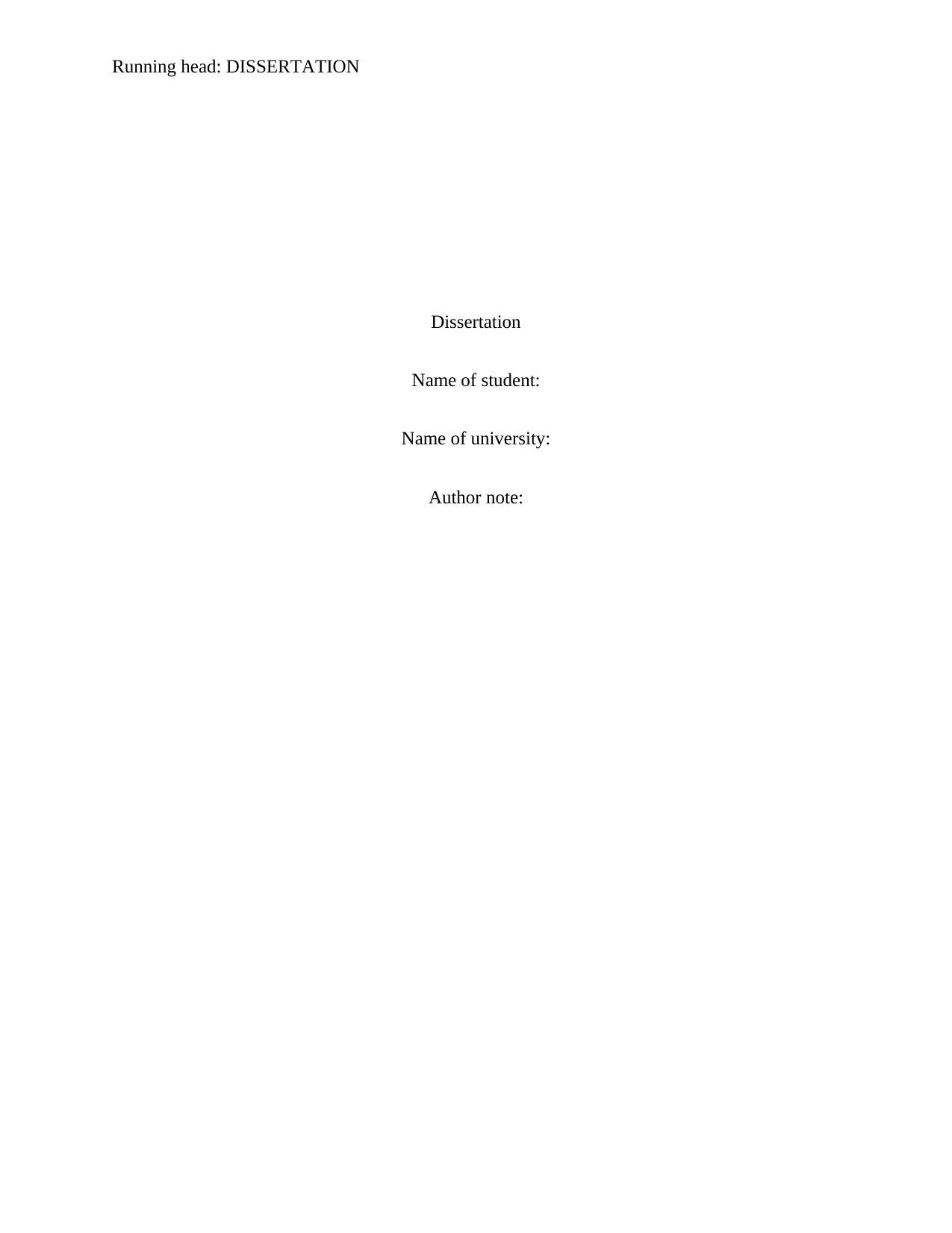
Running head: DISSERTATION
Dissertation
Name of student:
Name of university:
Author note:
Dissertation
Name of student:
Name of university:
Author note:
Secure Best Marks with AI Grader
Need help grading? Try our AI Grader for instant feedback on your assignments.
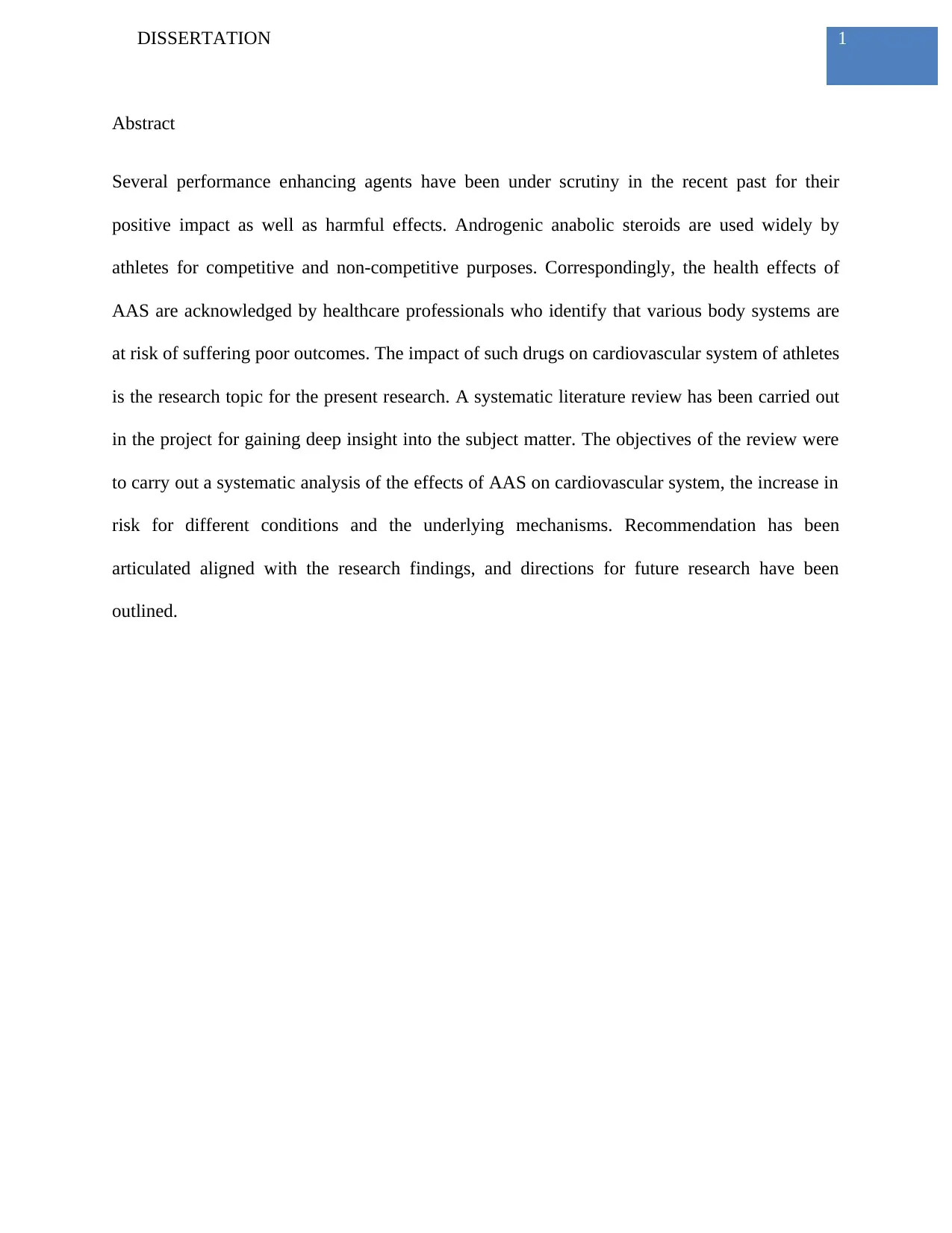
1DISSERTATION
Abstract
Several performance enhancing agents have been under scrutiny in the recent past for their
positive impact as well as harmful effects. Androgenic anabolic steroids are used widely by
athletes for competitive and non-competitive purposes. Correspondingly, the health effects of
AAS are acknowledged by healthcare professionals who identify that various body systems are
at risk of suffering poor outcomes. The impact of such drugs on cardiovascular system of athletes
is the research topic for the present research. A systematic literature review has been carried out
in the project for gaining deep insight into the subject matter. The objectives of the review were
to carry out a systematic analysis of the effects of AAS on cardiovascular system, the increase in
risk for different conditions and the underlying mechanisms. Recommendation has been
articulated aligned with the research findings, and directions for future research have been
outlined.
Abstract
Several performance enhancing agents have been under scrutiny in the recent past for their
positive impact as well as harmful effects. Androgenic anabolic steroids are used widely by
athletes for competitive and non-competitive purposes. Correspondingly, the health effects of
AAS are acknowledged by healthcare professionals who identify that various body systems are
at risk of suffering poor outcomes. The impact of such drugs on cardiovascular system of athletes
is the research topic for the present research. A systematic literature review has been carried out
in the project for gaining deep insight into the subject matter. The objectives of the review were
to carry out a systematic analysis of the effects of AAS on cardiovascular system, the increase in
risk for different conditions and the underlying mechanisms. Recommendation has been
articulated aligned with the research findings, and directions for future research have been
outlined.
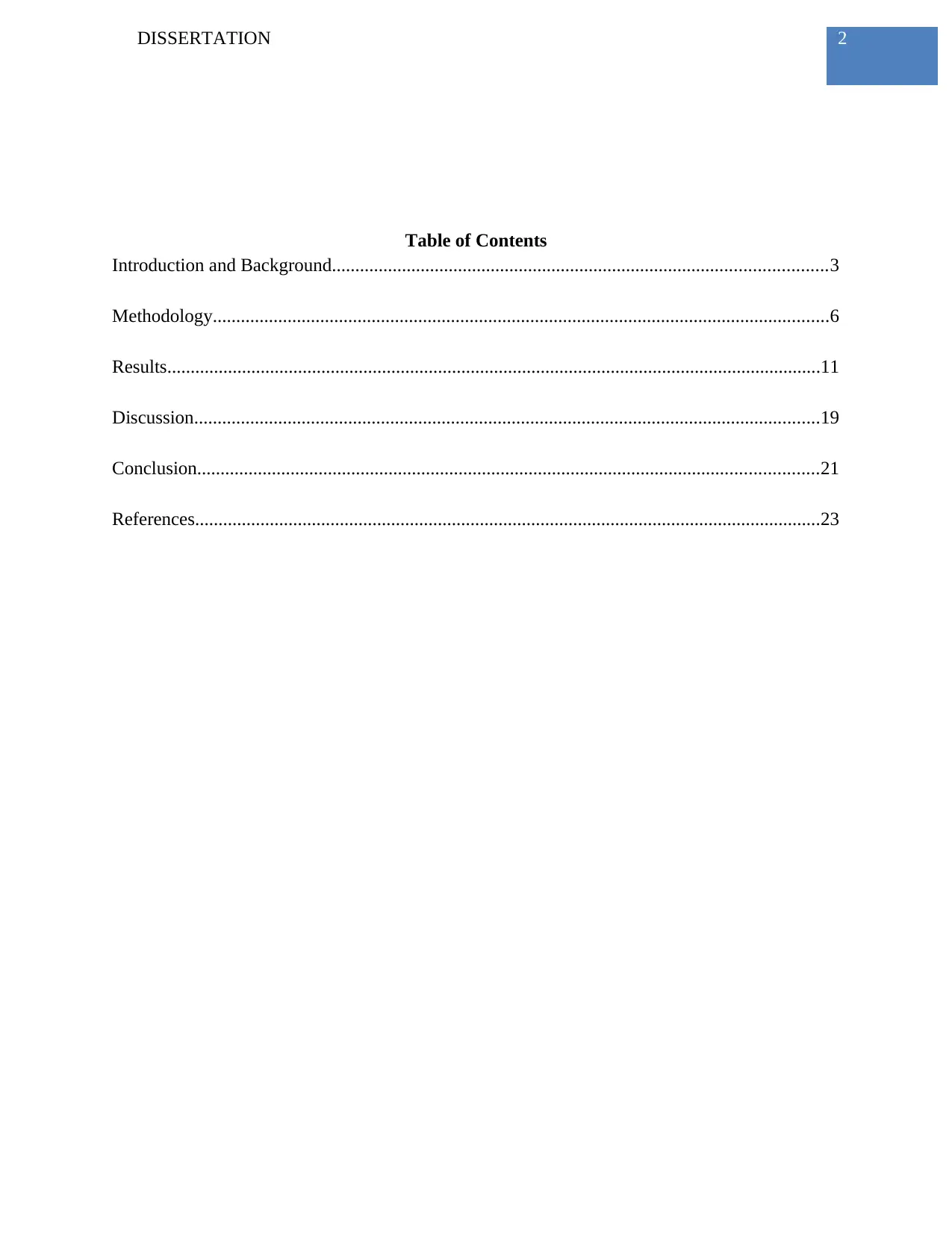
2DISSERTATION
Table of Contents
Introduction and Background..........................................................................................................3
Methodology....................................................................................................................................6
Results............................................................................................................................................11
Discussion......................................................................................................................................19
Conclusion.....................................................................................................................................21
References......................................................................................................................................23
Table of Contents
Introduction and Background..........................................................................................................3
Methodology....................................................................................................................................6
Results............................................................................................................................................11
Discussion......................................................................................................................................19
Conclusion.....................................................................................................................................21
References......................................................................................................................................23
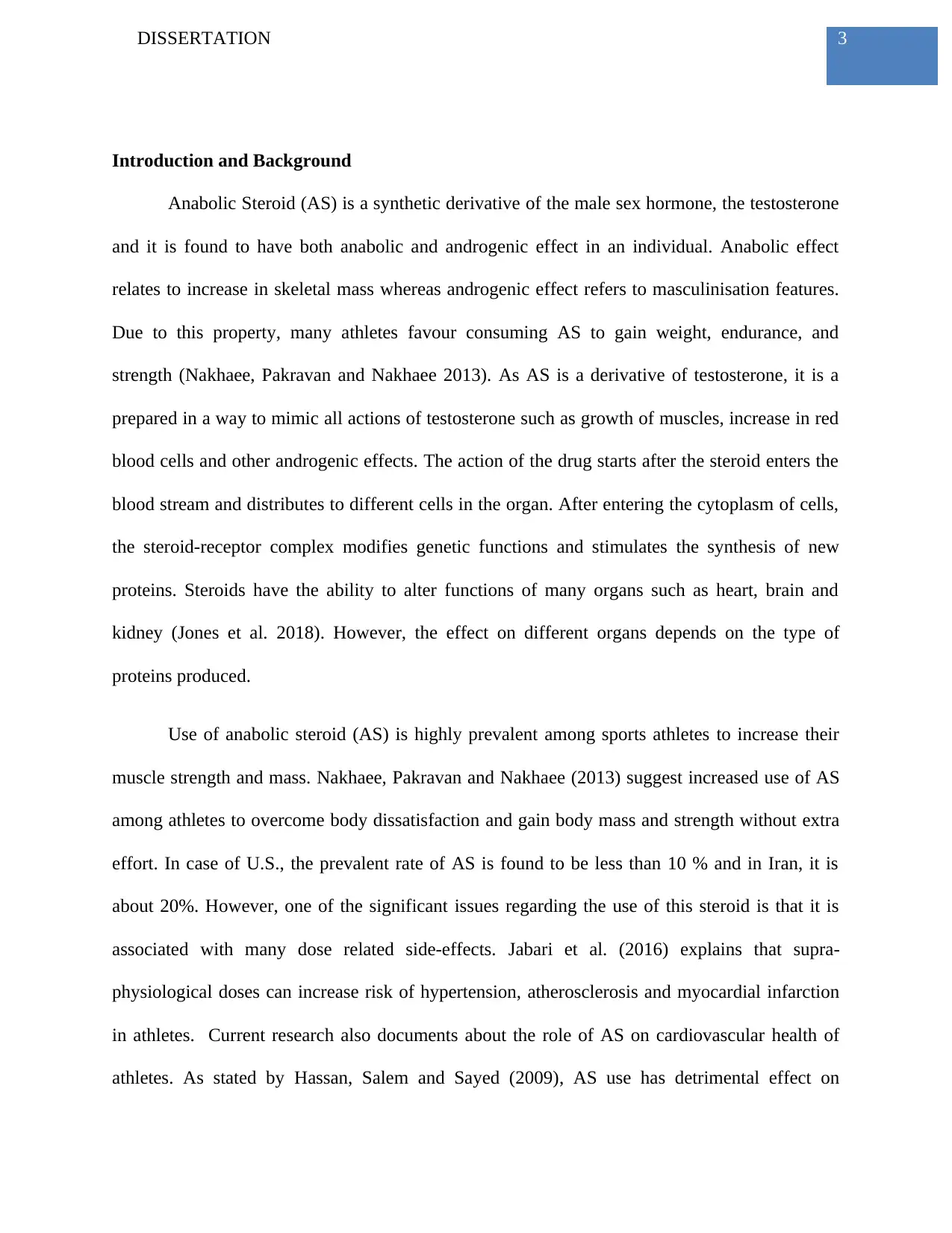
3DISSERTATION
Introduction and Background
Anabolic Steroid (AS) is a synthetic derivative of the male sex hormone, the testosterone
and it is found to have both anabolic and androgenic effect in an individual. Anabolic effect
relates to increase in skeletal mass whereas androgenic effect refers to masculinisation features.
Due to this property, many athletes favour consuming AS to gain weight, endurance, and
strength (Nakhaee, Pakravan and Nakhaee 2013). As AS is a derivative of testosterone, it is a
prepared in a way to mimic all actions of testosterone such as growth of muscles, increase in red
blood cells and other androgenic effects. The action of the drug starts after the steroid enters the
blood stream and distributes to different cells in the organ. After entering the cytoplasm of cells,
the steroid-receptor complex modifies genetic functions and stimulates the synthesis of new
proteins. Steroids have the ability to alter functions of many organs such as heart, brain and
kidney (Jones et al. 2018). However, the effect on different organs depends on the type of
proteins produced.
Use of anabolic steroid (AS) is highly prevalent among sports athletes to increase their
muscle strength and mass. Nakhaee, Pakravan and Nakhaee (2013) suggest increased use of AS
among athletes to overcome body dissatisfaction and gain body mass and strength without extra
effort. In case of U.S., the prevalent rate of AS is found to be less than 10 % and in Iran, it is
about 20%. However, one of the significant issues regarding the use of this steroid is that it is
associated with many dose related side-effects. Jabari et al. (2016) explains that supra-
physiological doses can increase risk of hypertension, atherosclerosis and myocardial infarction
in athletes. Current research also documents about the role of AS on cardiovascular health of
athletes. As stated by Hassan, Salem and Sayed (2009), AS use has detrimental effect on
Introduction and Background
Anabolic Steroid (AS) is a synthetic derivative of the male sex hormone, the testosterone
and it is found to have both anabolic and androgenic effect in an individual. Anabolic effect
relates to increase in skeletal mass whereas androgenic effect refers to masculinisation features.
Due to this property, many athletes favour consuming AS to gain weight, endurance, and
strength (Nakhaee, Pakravan and Nakhaee 2013). As AS is a derivative of testosterone, it is a
prepared in a way to mimic all actions of testosterone such as growth of muscles, increase in red
blood cells and other androgenic effects. The action of the drug starts after the steroid enters the
blood stream and distributes to different cells in the organ. After entering the cytoplasm of cells,
the steroid-receptor complex modifies genetic functions and stimulates the synthesis of new
proteins. Steroids have the ability to alter functions of many organs such as heart, brain and
kidney (Jones et al. 2018). However, the effect on different organs depends on the type of
proteins produced.
Use of anabolic steroid (AS) is highly prevalent among sports athletes to increase their
muscle strength and mass. Nakhaee, Pakravan and Nakhaee (2013) suggest increased use of AS
among athletes to overcome body dissatisfaction and gain body mass and strength without extra
effort. In case of U.S., the prevalent rate of AS is found to be less than 10 % and in Iran, it is
about 20%. However, one of the significant issues regarding the use of this steroid is that it is
associated with many dose related side-effects. Jabari et al. (2016) explains that supra-
physiological doses can increase risk of hypertension, atherosclerosis and myocardial infarction
in athletes. Current research also documents about the role of AS on cardiovascular health of
athletes. As stated by Hassan, Salem and Sayed (2009), AS use has detrimental effect on
Secure Best Marks with AI Grader
Need help grading? Try our AI Grader for instant feedback on your assignments.
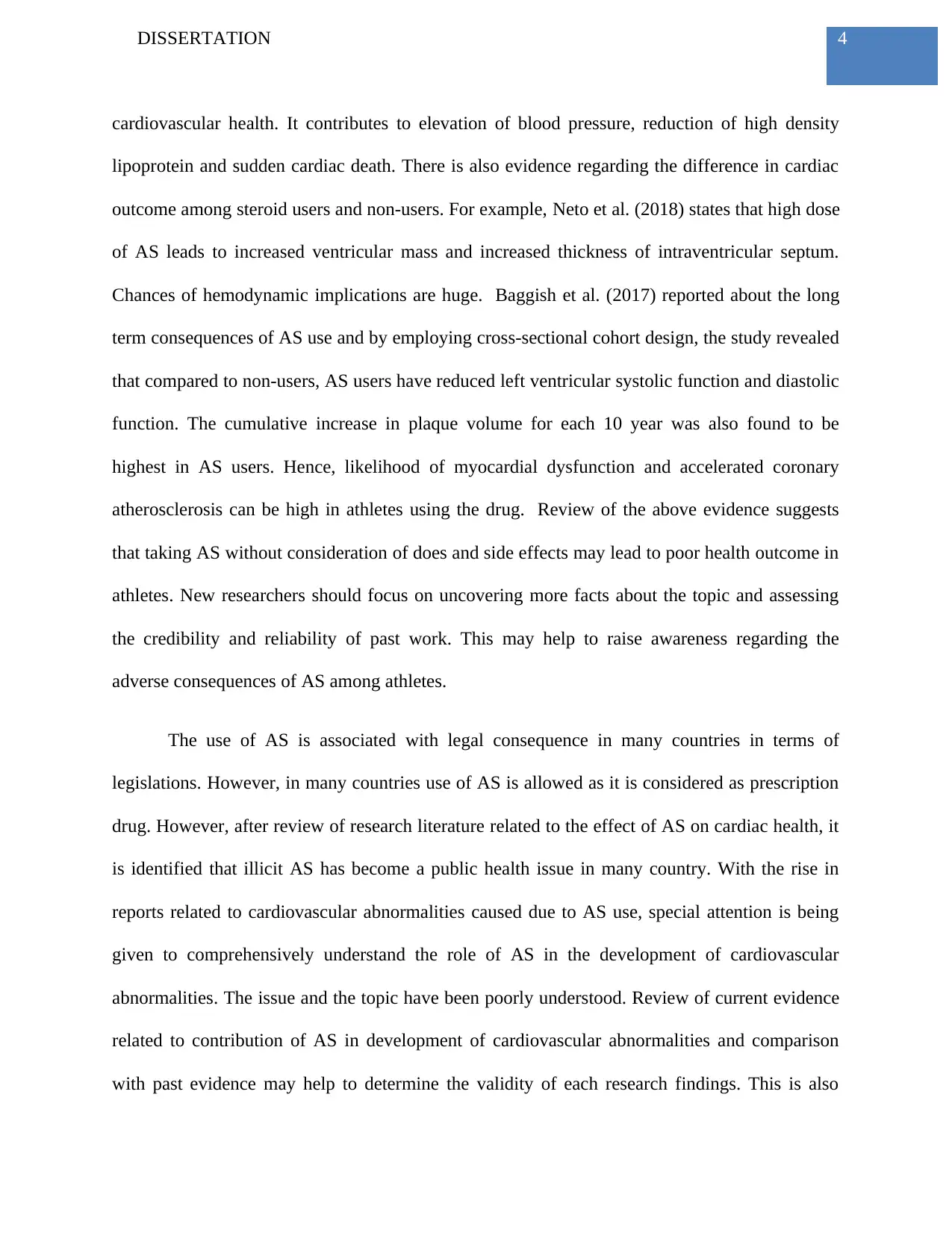
4DISSERTATION
cardiovascular health. It contributes to elevation of blood pressure, reduction of high density
lipoprotein and sudden cardiac death. There is also evidence regarding the difference in cardiac
outcome among steroid users and non-users. For example, Neto et al. (2018) states that high dose
of AS leads to increased ventricular mass and increased thickness of intraventricular septum.
Chances of hemodynamic implications are huge. Baggish et al. (2017) reported about the long
term consequences of AS use and by employing cross-sectional cohort design, the study revealed
that compared to non-users, AS users have reduced left ventricular systolic function and diastolic
function. The cumulative increase in plaque volume for each 10 year was also found to be
highest in AS users. Hence, likelihood of myocardial dysfunction and accelerated coronary
atherosclerosis can be high in athletes using the drug. Review of the above evidence suggests
that taking AS without consideration of does and side effects may lead to poor health outcome in
athletes. New researchers should focus on uncovering more facts about the topic and assessing
the credibility and reliability of past work. This may help to raise awareness regarding the
adverse consequences of AS among athletes.
The use of AS is associated with legal consequence in many countries in terms of
legislations. However, in many countries use of AS is allowed as it is considered as prescription
drug. However, after review of research literature related to the effect of AS on cardiac health, it
is identified that illicit AS has become a public health issue in many country. With the rise in
reports related to cardiovascular abnormalities caused due to AS use, special attention is being
given to comprehensively understand the role of AS in the development of cardiovascular
abnormalities. The issue and the topic have been poorly understood. Review of current evidence
related to contribution of AS in development of cardiovascular abnormalities and comparison
with past evidence may help to determine the validity of each research findings. This is also
cardiovascular health. It contributes to elevation of blood pressure, reduction of high density
lipoprotein and sudden cardiac death. There is also evidence regarding the difference in cardiac
outcome among steroid users and non-users. For example, Neto et al. (2018) states that high dose
of AS leads to increased ventricular mass and increased thickness of intraventricular septum.
Chances of hemodynamic implications are huge. Baggish et al. (2017) reported about the long
term consequences of AS use and by employing cross-sectional cohort design, the study revealed
that compared to non-users, AS users have reduced left ventricular systolic function and diastolic
function. The cumulative increase in plaque volume for each 10 year was also found to be
highest in AS users. Hence, likelihood of myocardial dysfunction and accelerated coronary
atherosclerosis can be high in athletes using the drug. Review of the above evidence suggests
that taking AS without consideration of does and side effects may lead to poor health outcome in
athletes. New researchers should focus on uncovering more facts about the topic and assessing
the credibility and reliability of past work. This may help to raise awareness regarding the
adverse consequences of AS among athletes.
The use of AS is associated with legal consequence in many countries in terms of
legislations. However, in many countries use of AS is allowed as it is considered as prescription
drug. However, after review of research literature related to the effect of AS on cardiac health, it
is identified that illicit AS has become a public health issue in many country. With the rise in
reports related to cardiovascular abnormalities caused due to AS use, special attention is being
given to comprehensively understand the role of AS in the development of cardiovascular
abnormalities. The issue and the topic have been poorly understood. Review of current evidence
related to contribution of AS in development of cardiovascular abnormalities and comparison
with past evidence may help to determine the validity of each research findings. This is also
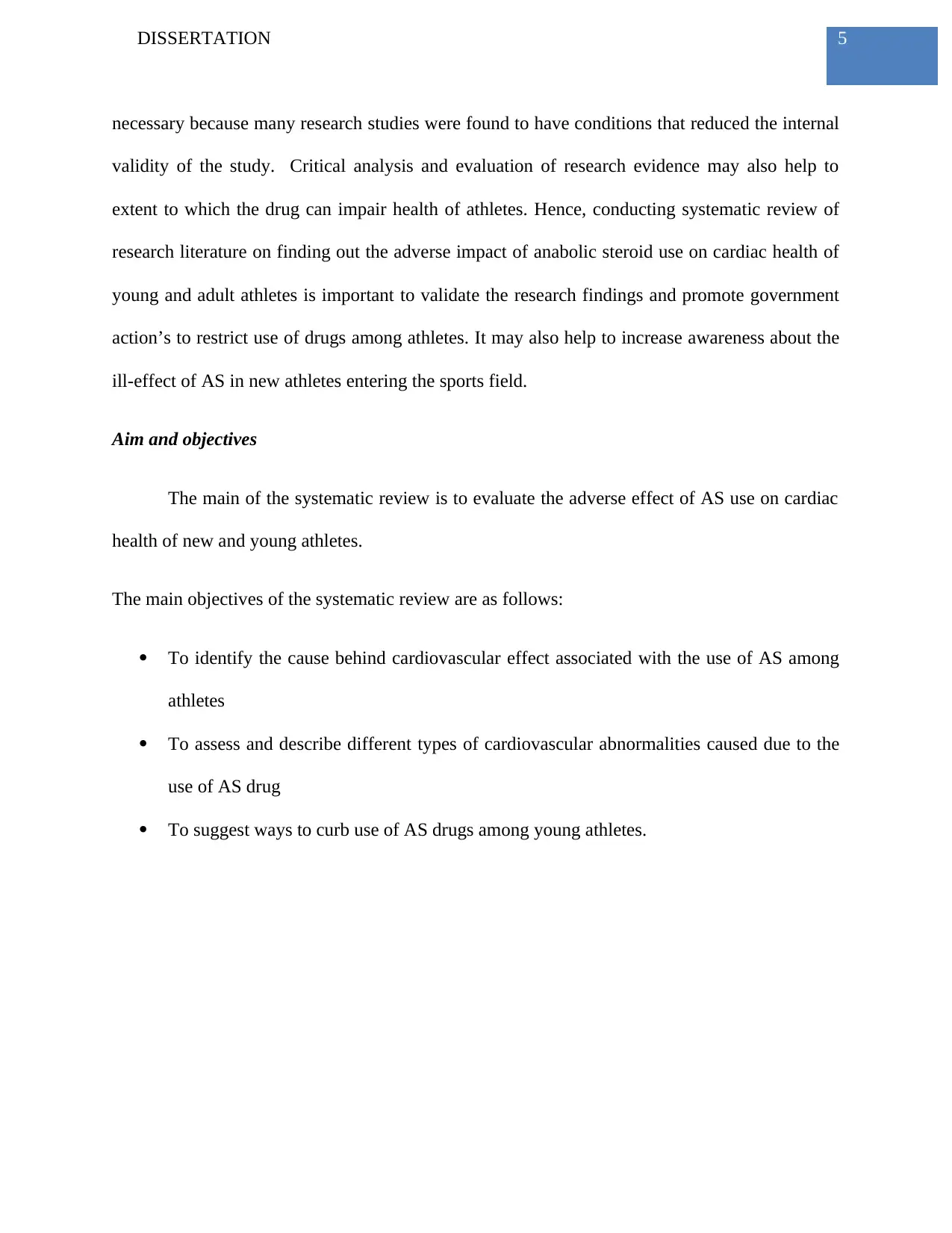
5DISSERTATION
necessary because many research studies were found to have conditions that reduced the internal
validity of the study. Critical analysis and evaluation of research evidence may also help to
extent to which the drug can impair health of athletes. Hence, conducting systematic review of
research literature on finding out the adverse impact of anabolic steroid use on cardiac health of
young and adult athletes is important to validate the research findings and promote government
action’s to restrict use of drugs among athletes. It may also help to increase awareness about the
ill-effect of AS in new athletes entering the sports field.
Aim and objectives
The main of the systematic review is to evaluate the adverse effect of AS use on cardiac
health of new and young athletes.
The main objectives of the systematic review are as follows:
To identify the cause behind cardiovascular effect associated with the use of AS among
athletes
To assess and describe different types of cardiovascular abnormalities caused due to the
use of AS drug
To suggest ways to curb use of AS drugs among young athletes.
necessary because many research studies were found to have conditions that reduced the internal
validity of the study. Critical analysis and evaluation of research evidence may also help to
extent to which the drug can impair health of athletes. Hence, conducting systematic review of
research literature on finding out the adverse impact of anabolic steroid use on cardiac health of
young and adult athletes is important to validate the research findings and promote government
action’s to restrict use of drugs among athletes. It may also help to increase awareness about the
ill-effect of AS in new athletes entering the sports field.
Aim and objectives
The main of the systematic review is to evaluate the adverse effect of AS use on cardiac
health of new and young athletes.
The main objectives of the systematic review are as follows:
To identify the cause behind cardiovascular effect associated with the use of AS among
athletes
To assess and describe different types of cardiovascular abnormalities caused due to the
use of AS drug
To suggest ways to curb use of AS drugs among young athletes.
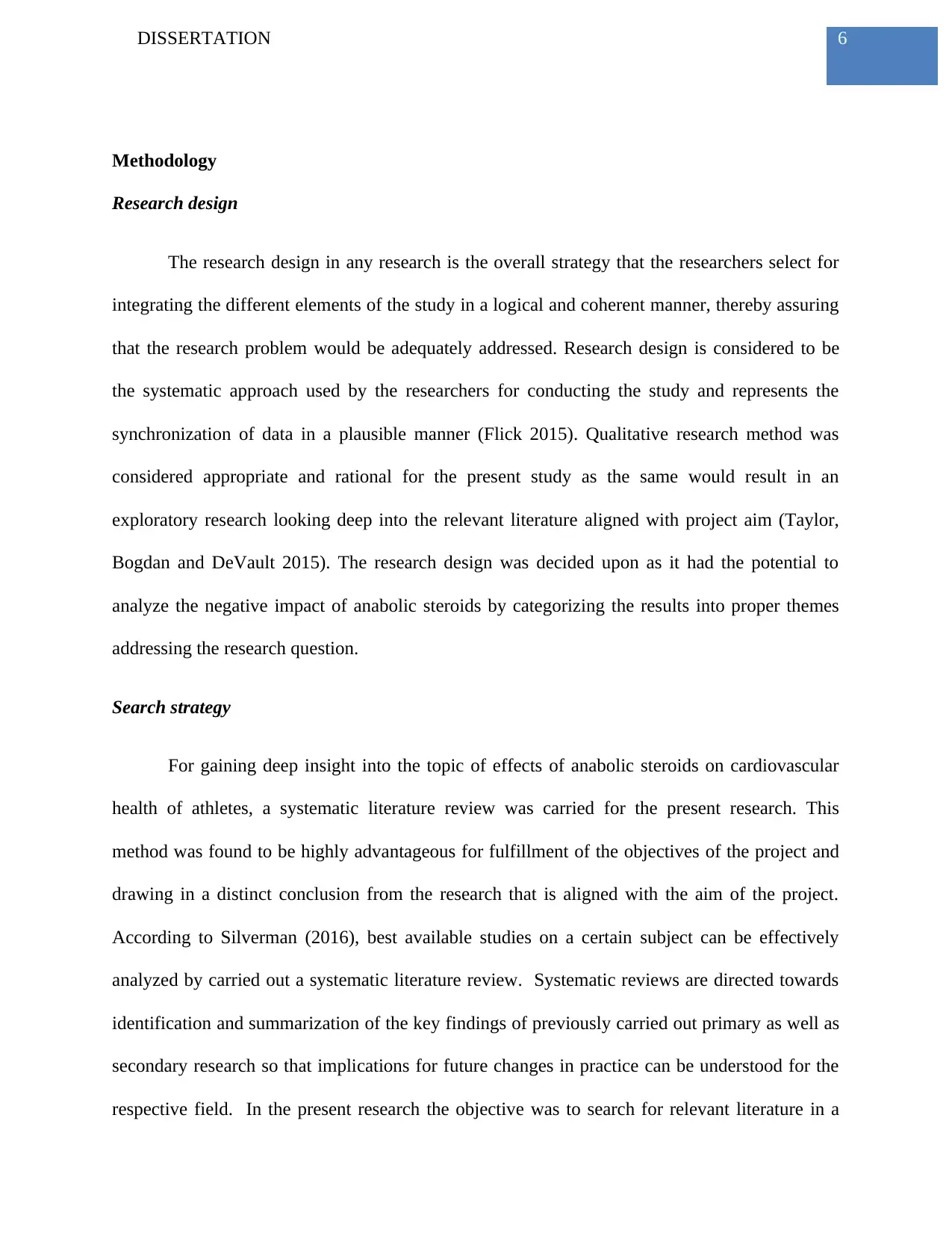
6DISSERTATION
Methodology
Research design
The research design in any research is the overall strategy that the researchers select for
integrating the different elements of the study in a logical and coherent manner, thereby assuring
that the research problem would be adequately addressed. Research design is considered to be
the systematic approach used by the researchers for conducting the study and represents the
synchronization of data in a plausible manner (Flick 2015). Qualitative research method was
considered appropriate and rational for the present study as the same would result in an
exploratory research looking deep into the relevant literature aligned with project aim (Taylor,
Bogdan and DeVault 2015). The research design was decided upon as it had the potential to
analyze the negative impact of anabolic steroids by categorizing the results into proper themes
addressing the research question.
Search strategy
For gaining deep insight into the topic of effects of anabolic steroids on cardiovascular
health of athletes, a systematic literature review was carried for the present research. This
method was found to be highly advantageous for fulfillment of the objectives of the project and
drawing in a distinct conclusion from the research that is aligned with the aim of the project.
According to Silverman (2016), best available studies on a certain subject can be effectively
analyzed by carried out a systematic literature review. Systematic reviews are directed towards
identification and summarization of the key findings of previously carried out primary as well as
secondary research so that implications for future changes in practice can be understood for the
respective field. In the present research the objective was to search for relevant literature in a
Methodology
Research design
The research design in any research is the overall strategy that the researchers select for
integrating the different elements of the study in a logical and coherent manner, thereby assuring
that the research problem would be adequately addressed. Research design is considered to be
the systematic approach used by the researchers for conducting the study and represents the
synchronization of data in a plausible manner (Flick 2015). Qualitative research method was
considered appropriate and rational for the present study as the same would result in an
exploratory research looking deep into the relevant literature aligned with project aim (Taylor,
Bogdan and DeVault 2015). The research design was decided upon as it had the potential to
analyze the negative impact of anabolic steroids by categorizing the results into proper themes
addressing the research question.
Search strategy
For gaining deep insight into the topic of effects of anabolic steroids on cardiovascular
health of athletes, a systematic literature review was carried for the present research. This
method was found to be highly advantageous for fulfillment of the objectives of the project and
drawing in a distinct conclusion from the research that is aligned with the aim of the project.
According to Silverman (2016), best available studies on a certain subject can be effectively
analyzed by carried out a systematic literature review. Systematic reviews are directed towards
identification and summarization of the key findings of previously carried out primary as well as
secondary research so that implications for future changes in practice can be understood for the
respective field. In the present research the objective was to search for relevant literature in a
Paraphrase This Document
Need a fresh take? Get an instant paraphrase of this document with our AI Paraphraser
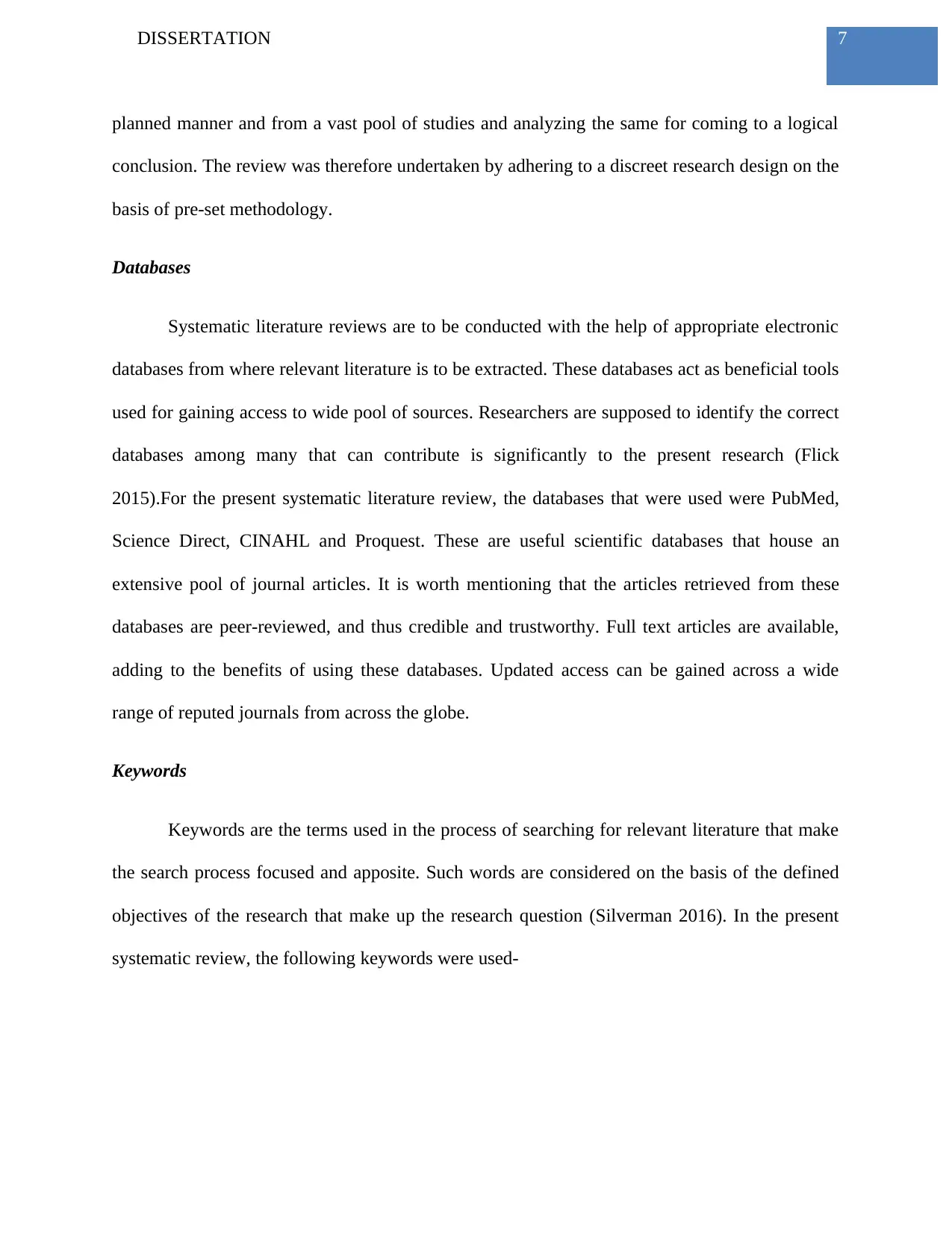
7DISSERTATION
planned manner and from a vast pool of studies and analyzing the same for coming to a logical
conclusion. The review was therefore undertaken by adhering to a discreet research design on the
basis of pre-set methodology.
Databases
Systematic literature reviews are to be conducted with the help of appropriate electronic
databases from where relevant literature is to be extracted. These databases act as beneficial tools
used for gaining access to wide pool of sources. Researchers are supposed to identify the correct
databases among many that can contribute is significantly to the present research (Flick
2015).For the present systematic literature review, the databases that were used were PubMed,
Science Direct, CINAHL and Proquest. These are useful scientific databases that house an
extensive pool of journal articles. It is worth mentioning that the articles retrieved from these
databases are peer-reviewed, and thus credible and trustworthy. Full text articles are available,
adding to the benefits of using these databases. Updated access can be gained across a wide
range of reputed journals from across the globe.
Keywords
Keywords are the terms used in the process of searching for relevant literature that make
the search process focused and apposite. Such words are considered on the basis of the defined
objectives of the research that make up the research question (Silverman 2016). In the present
systematic review, the following keywords were used-
planned manner and from a vast pool of studies and analyzing the same for coming to a logical
conclusion. The review was therefore undertaken by adhering to a discreet research design on the
basis of pre-set methodology.
Databases
Systematic literature reviews are to be conducted with the help of appropriate electronic
databases from where relevant literature is to be extracted. These databases act as beneficial tools
used for gaining access to wide pool of sources. Researchers are supposed to identify the correct
databases among many that can contribute is significantly to the present research (Flick
2015).For the present systematic literature review, the databases that were used were PubMed,
Science Direct, CINAHL and Proquest. These are useful scientific databases that house an
extensive pool of journal articles. It is worth mentioning that the articles retrieved from these
databases are peer-reviewed, and thus credible and trustworthy. Full text articles are available,
adding to the benefits of using these databases. Updated access can be gained across a wide
range of reputed journals from across the globe.
Keywords
Keywords are the terms used in the process of searching for relevant literature that make
the search process focused and apposite. Such words are considered on the basis of the defined
objectives of the research that make up the research question (Silverman 2016). In the present
systematic review, the following keywords were used-
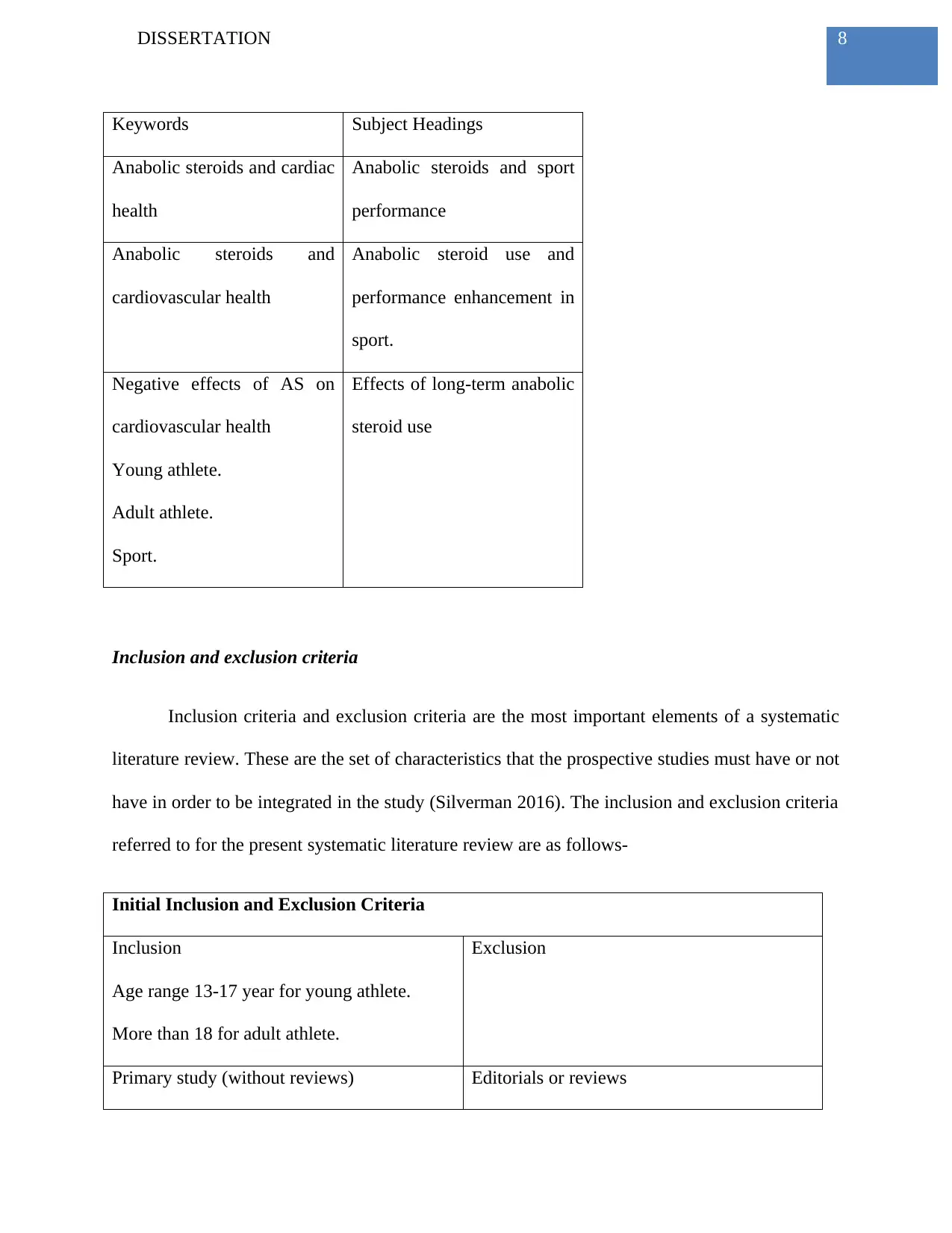
8DISSERTATION
Keywords Subject Headings
Anabolic steroids and cardiac
health
Anabolic steroids and sport
performance
Anabolic steroids and
cardiovascular health
Anabolic steroid use and
performance enhancement in
sport.
Negative effects of AS on
cardiovascular health
Young athlete.
Adult athlete.
Sport.
Effects of long-term anabolic
steroid use
Inclusion and exclusion criteria
Inclusion criteria and exclusion criteria are the most important elements of a systematic
literature review. These are the set of characteristics that the prospective studies must have or not
have in order to be integrated in the study (Silverman 2016). The inclusion and exclusion criteria
referred to for the present systematic literature review are as follows-
Initial Inclusion and Exclusion Criteria
Inclusion
Age range 13-17 year for young athlete.
More than 18 for adult athlete.
Exclusion
Primary study (without reviews) Editorials or reviews
Keywords Subject Headings
Anabolic steroids and cardiac
health
Anabolic steroids and sport
performance
Anabolic steroids and
cardiovascular health
Anabolic steroid use and
performance enhancement in
sport.
Negative effects of AS on
cardiovascular health
Young athlete.
Adult athlete.
Sport.
Effects of long-term anabolic
steroid use
Inclusion and exclusion criteria
Inclusion criteria and exclusion criteria are the most important elements of a systematic
literature review. These are the set of characteristics that the prospective studies must have or not
have in order to be integrated in the study (Silverman 2016). The inclusion and exclusion criteria
referred to for the present systematic literature review are as follows-
Initial Inclusion and Exclusion Criteria
Inclusion
Age range 13-17 year for young athlete.
More than 18 for adult athlete.
Exclusion
Primary study (without reviews) Editorials or reviews
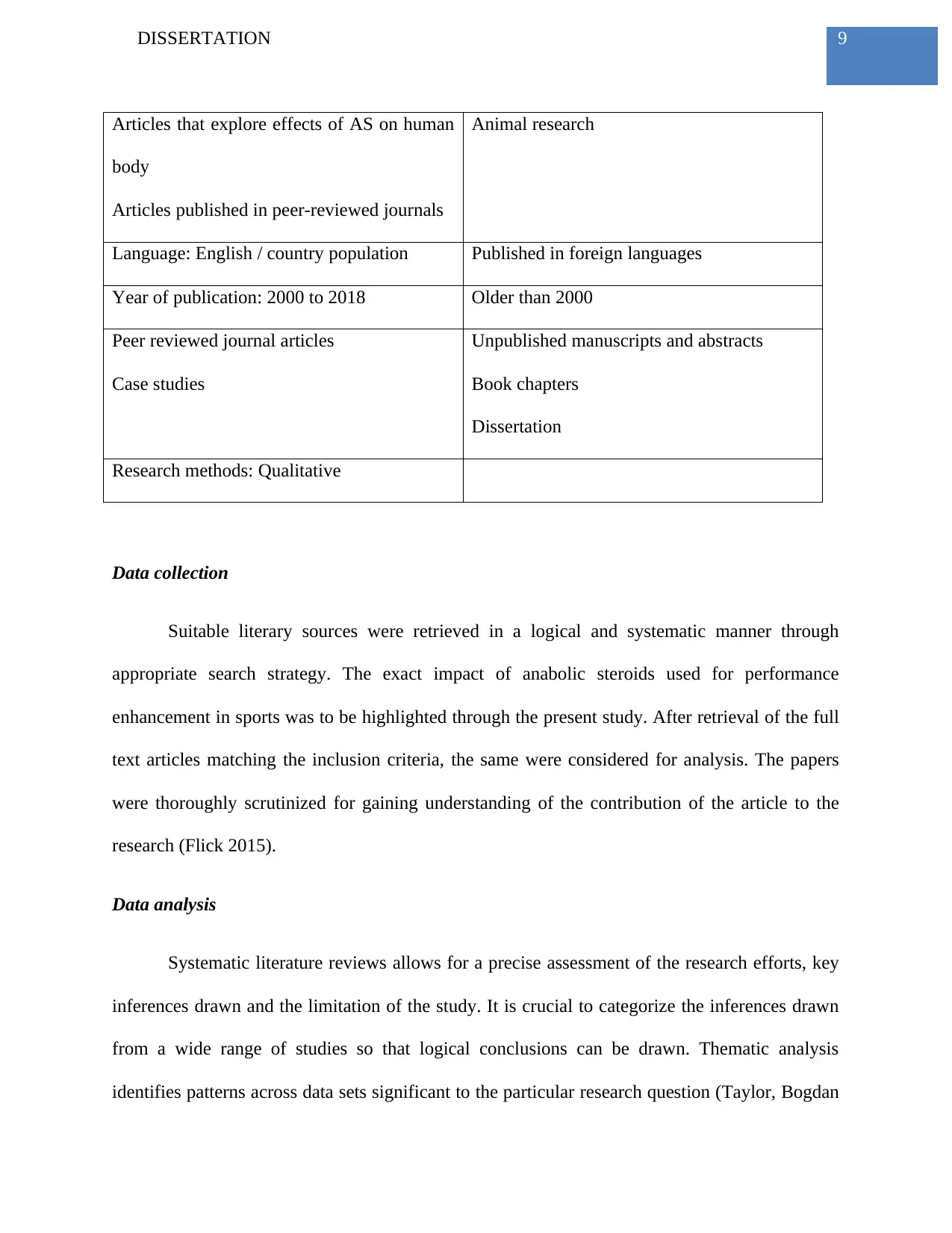
9DISSERTATION
Articles that explore effects of AS on human
body
Articles published in peer-reviewed journals
Animal research
Language: English / country population Published in foreign languages
Year of publication: 2000 to 2018 Older than 2000
Peer reviewed journal articles
Case studies
Unpublished manuscripts and abstracts
Book chapters
Dissertation
Research methods: Qualitative
Data collection
Suitable literary sources were retrieved in a logical and systematic manner through
appropriate search strategy. The exact impact of anabolic steroids used for performance
enhancement in sports was to be highlighted through the present study. After retrieval of the full
text articles matching the inclusion criteria, the same were considered for analysis. The papers
were thoroughly scrutinized for gaining understanding of the contribution of the article to the
research (Flick 2015).
Data analysis
Systematic literature reviews allows for a precise assessment of the research efforts, key
inferences drawn and the limitation of the study. It is crucial to categorize the inferences drawn
from a wide range of studies so that logical conclusions can be drawn. Thematic analysis
identifies patterns across data sets significant to the particular research question (Taylor, Bogdan
Articles that explore effects of AS on human
body
Articles published in peer-reviewed journals
Animal research
Language: English / country population Published in foreign languages
Year of publication: 2000 to 2018 Older than 2000
Peer reviewed journal articles
Case studies
Unpublished manuscripts and abstracts
Book chapters
Dissertation
Research methods: Qualitative
Data collection
Suitable literary sources were retrieved in a logical and systematic manner through
appropriate search strategy. The exact impact of anabolic steroids used for performance
enhancement in sports was to be highlighted through the present study. After retrieval of the full
text articles matching the inclusion criteria, the same were considered for analysis. The papers
were thoroughly scrutinized for gaining understanding of the contribution of the article to the
research (Flick 2015).
Data analysis
Systematic literature reviews allows for a precise assessment of the research efforts, key
inferences drawn and the limitation of the study. It is crucial to categorize the inferences drawn
from a wide range of studies so that logical conclusions can be drawn. Thematic analysis
identifies patterns across data sets significant to the particular research question (Taylor, Bogdan
Secure Best Marks with AI Grader
Need help grading? Try our AI Grader for instant feedback on your assignments.
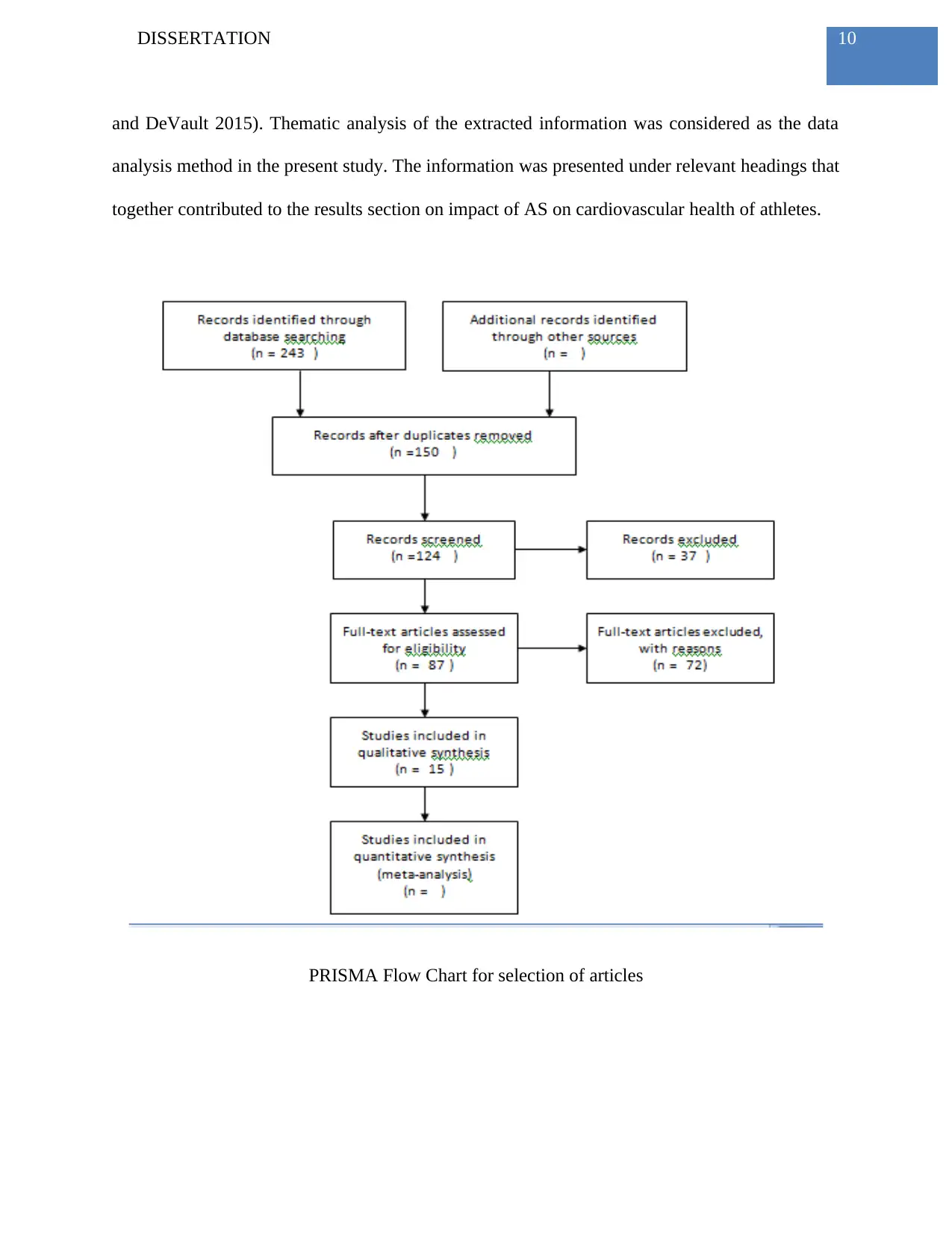
10DISSERTATION
and DeVault 2015). Thematic analysis of the extracted information was considered as the data
analysis method in the present study. The information was presented under relevant headings that
together contributed to the results section on impact of AS on cardiovascular health of athletes.
PRISMA Flow Chart for selection of articles
and DeVault 2015). Thematic analysis of the extracted information was considered as the data
analysis method in the present study. The information was presented under relevant headings that
together contributed to the results section on impact of AS on cardiovascular health of athletes.
PRISMA Flow Chart for selection of articles
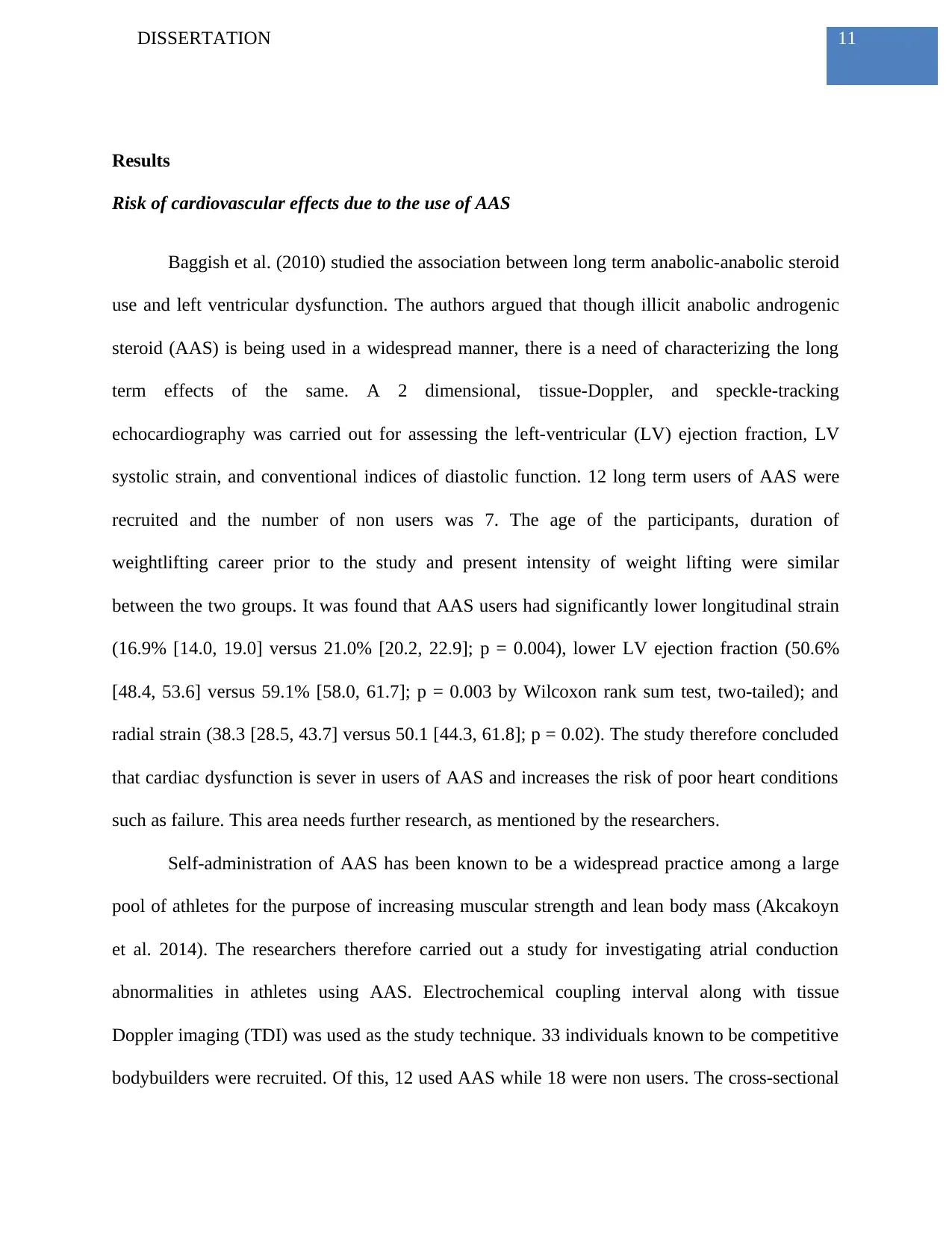
11DISSERTATION
Results
Risk of cardiovascular effects due to the use of AAS
Baggish et al. (2010) studied the association between long term anabolic-anabolic steroid
use and left ventricular dysfunction. The authors argued that though illicit anabolic androgenic
steroid (AAS) is being used in a widespread manner, there is a need of characterizing the long
term effects of the same. A 2 dimensional, tissue-Doppler, and speckle-tracking
echocardiography was carried out for assessing the left-ventricular (LV) ejection fraction, LV
systolic strain, and conventional indices of diastolic function. 12 long term users of AAS were
recruited and the number of non users was 7. The age of the participants, duration of
weightlifting career prior to the study and present intensity of weight lifting were similar
between the two groups. It was found that AAS users had significantly lower longitudinal strain
(16.9% [14.0, 19.0] versus 21.0% [20.2, 22.9]; p = 0.004), lower LV ejection fraction (50.6%
[48.4, 53.6] versus 59.1% [58.0, 61.7]; p = 0.003 by Wilcoxon rank sum test, two-tailed); and
radial strain (38.3 [28.5, 43.7] versus 50.1 [44.3, 61.8]; p = 0.02). The study therefore concluded
that cardiac dysfunction is sever in users of AAS and increases the risk of poor heart conditions
such as failure. This area needs further research, as mentioned by the researchers.
Self-administration of AAS has been known to be a widespread practice among a large
pool of athletes for the purpose of increasing muscular strength and lean body mass (Akcakoyn
et al. 2014). The researchers therefore carried out a study for investigating atrial conduction
abnormalities in athletes using AAS. Electrochemical coupling interval along with tissue
Doppler imaging (TDI) was used as the study technique. 33 individuals known to be competitive
bodybuilders were recruited. Of this, 12 used AAS while 18 were non users. The cross-sectional
Results
Risk of cardiovascular effects due to the use of AAS
Baggish et al. (2010) studied the association between long term anabolic-anabolic steroid
use and left ventricular dysfunction. The authors argued that though illicit anabolic androgenic
steroid (AAS) is being used in a widespread manner, there is a need of characterizing the long
term effects of the same. A 2 dimensional, tissue-Doppler, and speckle-tracking
echocardiography was carried out for assessing the left-ventricular (LV) ejection fraction, LV
systolic strain, and conventional indices of diastolic function. 12 long term users of AAS were
recruited and the number of non users was 7. The age of the participants, duration of
weightlifting career prior to the study and present intensity of weight lifting were similar
between the two groups. It was found that AAS users had significantly lower longitudinal strain
(16.9% [14.0, 19.0] versus 21.0% [20.2, 22.9]; p = 0.004), lower LV ejection fraction (50.6%
[48.4, 53.6] versus 59.1% [58.0, 61.7]; p = 0.003 by Wilcoxon rank sum test, two-tailed); and
radial strain (38.3 [28.5, 43.7] versus 50.1 [44.3, 61.8]; p = 0.02). The study therefore concluded
that cardiac dysfunction is sever in users of AAS and increases the risk of poor heart conditions
such as failure. This area needs further research, as mentioned by the researchers.
Self-administration of AAS has been known to be a widespread practice among a large
pool of athletes for the purpose of increasing muscular strength and lean body mass (Akcakoyn
et al. 2014). The researchers therefore carried out a study for investigating atrial conduction
abnormalities in athletes using AAS. Electrochemical coupling interval along with tissue
Doppler imaging (TDI) was used as the study technique. 33 individuals known to be competitive
bodybuilders were recruited. Of this, 12 used AAS while 18 were non users. The cross-sectional
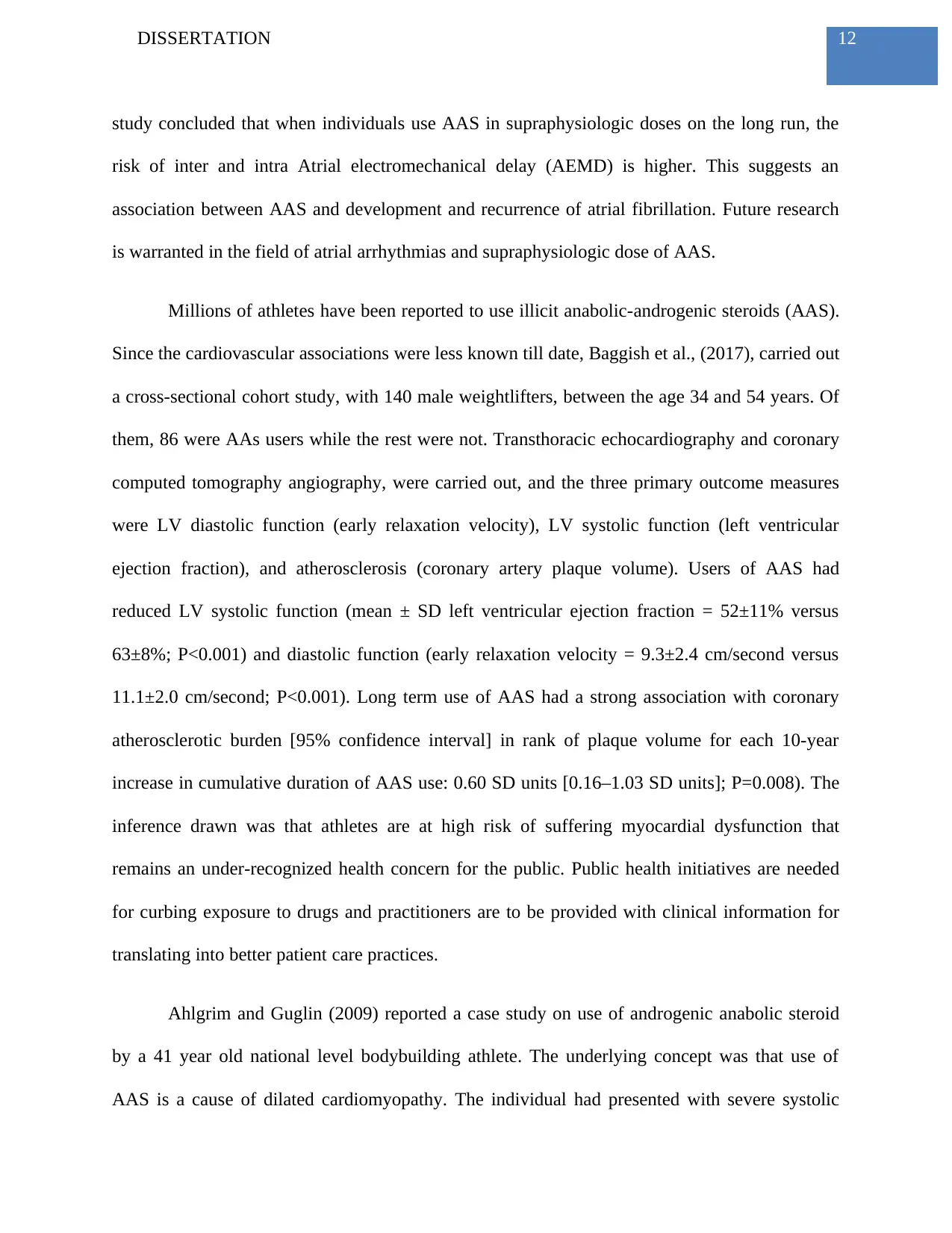
12DISSERTATION
study concluded that when individuals use AAS in supraphysiologic doses on the long run, the
risk of inter and intra Atrial electromechanical delay (AEMD) is higher. This suggests an
association between AAS and development and recurrence of atrial fibrillation. Future research
is warranted in the field of atrial arrhythmias and supraphysiologic dose of AAS.
Millions of athletes have been reported to use illicit anabolic-androgenic steroids (AAS).
Since the cardiovascular associations were less known till date, Baggish et al., (2017), carried out
a cross-sectional cohort study, with 140 male weightlifters, between the age 34 and 54 years. Of
them, 86 were AAs users while the rest were not. Transthoracic echocardiography and coronary
computed tomography angiography, were carried out, and the three primary outcome measures
were LV diastolic function (early relaxation velocity), LV systolic function (left ventricular
ejection fraction), and atherosclerosis (coronary artery plaque volume). Users of AAS had
reduced LV systolic function (mean ± SD left ventricular ejection fraction = 52±11% versus
63±8%; P<0.001) and diastolic function (early relaxation velocity = 9.3±2.4 cm/second versus
11.1±2.0 cm/second; P<0.001). Long term use of AAS had a strong association with coronary
atherosclerotic burden [95% confidence interval] in rank of plaque volume for each 10-year
increase in cumulative duration of AAS use: 0.60 SD units [0.16–1.03 SD units]; P=0.008). The
inference drawn was that athletes are at high risk of suffering myocardial dysfunction that
remains an under-recognized health concern for the public. Public health initiatives are needed
for curbing exposure to drugs and practitioners are to be provided with clinical information for
translating into better patient care practices.
Ahlgrim and Guglin (2009) reported a case study on use of androgenic anabolic steroid
by a 41 year old national level bodybuilding athlete. The underlying concept was that use of
AAS is a cause of dilated cardiomyopathy. The individual had presented with severe systolic
study concluded that when individuals use AAS in supraphysiologic doses on the long run, the
risk of inter and intra Atrial electromechanical delay (AEMD) is higher. This suggests an
association between AAS and development and recurrence of atrial fibrillation. Future research
is warranted in the field of atrial arrhythmias and supraphysiologic dose of AAS.
Millions of athletes have been reported to use illicit anabolic-androgenic steroids (AAS).
Since the cardiovascular associations were less known till date, Baggish et al., (2017), carried out
a cross-sectional cohort study, with 140 male weightlifters, between the age 34 and 54 years. Of
them, 86 were AAs users while the rest were not. Transthoracic echocardiography and coronary
computed tomography angiography, were carried out, and the three primary outcome measures
were LV diastolic function (early relaxation velocity), LV systolic function (left ventricular
ejection fraction), and atherosclerosis (coronary artery plaque volume). Users of AAS had
reduced LV systolic function (mean ± SD left ventricular ejection fraction = 52±11% versus
63±8%; P<0.001) and diastolic function (early relaxation velocity = 9.3±2.4 cm/second versus
11.1±2.0 cm/second; P<0.001). Long term use of AAS had a strong association with coronary
atherosclerotic burden [95% confidence interval] in rank of plaque volume for each 10-year
increase in cumulative duration of AAS use: 0.60 SD units [0.16–1.03 SD units]; P=0.008). The
inference drawn was that athletes are at high risk of suffering myocardial dysfunction that
remains an under-recognized health concern for the public. Public health initiatives are needed
for curbing exposure to drugs and practitioners are to be provided with clinical information for
translating into better patient care practices.
Ahlgrim and Guglin (2009) reported a case study on use of androgenic anabolic steroid
by a 41 year old national level bodybuilding athlete. The underlying concept was that use of
AAS is a cause of dilated cardiomyopathy. The individual had presented with severe systolic
Paraphrase This Document
Need a fresh take? Get an instant paraphrase of this document with our AI Paraphraser
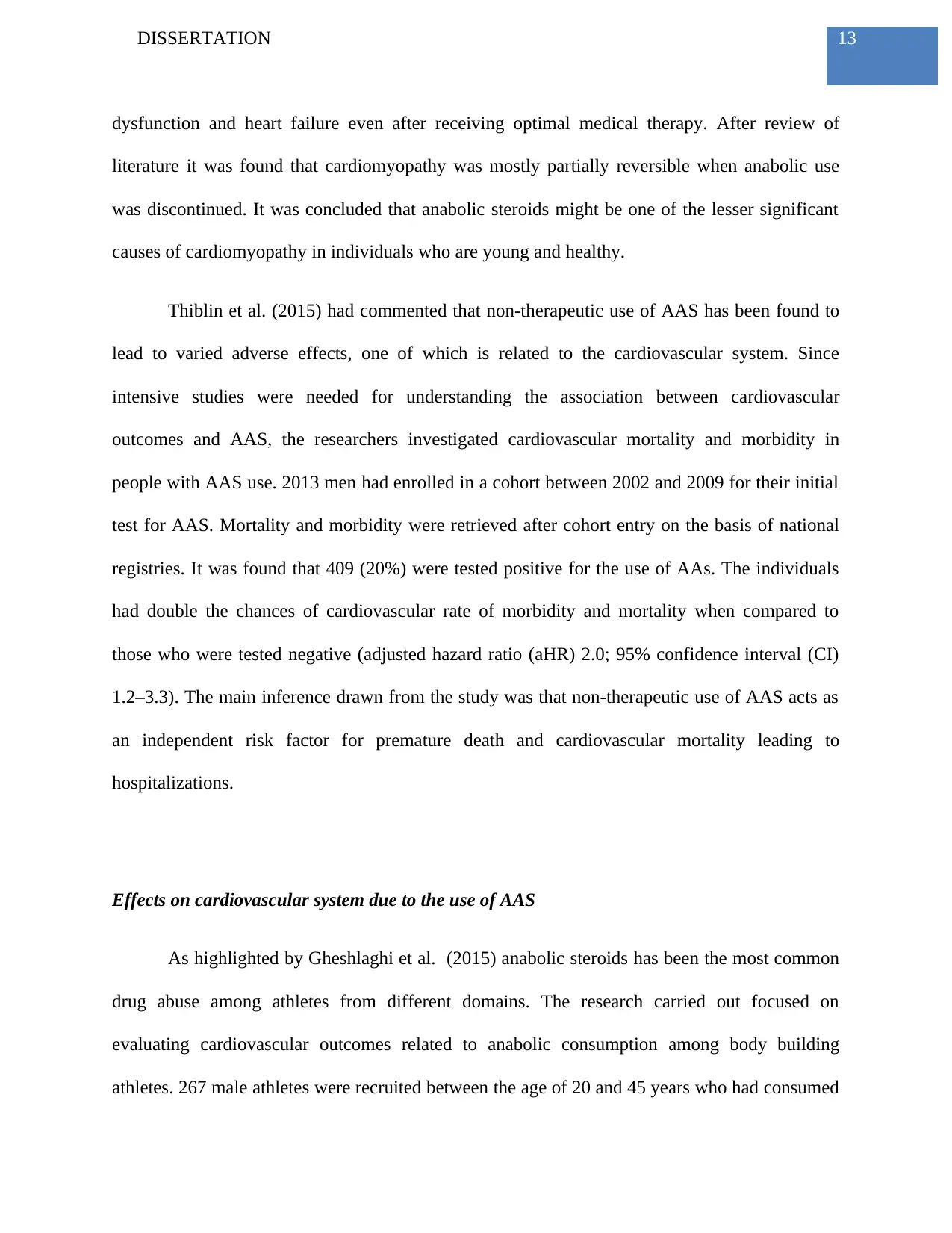
13DISSERTATION
dysfunction and heart failure even after receiving optimal medical therapy. After review of
literature it was found that cardiomyopathy was mostly partially reversible when anabolic use
was discontinued. It was concluded that anabolic steroids might be one of the lesser significant
causes of cardiomyopathy in individuals who are young and healthy.
Thiblin et al. (2015) had commented that non-therapeutic use of AAS has been found to
lead to varied adverse effects, one of which is related to the cardiovascular system. Since
intensive studies were needed for understanding the association between cardiovascular
outcomes and AAS, the researchers investigated cardiovascular mortality and morbidity in
people with AAS use. 2013 men had enrolled in a cohort between 2002 and 2009 for their initial
test for AAS. Mortality and morbidity were retrieved after cohort entry on the basis of national
registries. It was found that 409 (20%) were tested positive for the use of AAs. The individuals
had double the chances of cardiovascular rate of morbidity and mortality when compared to
those who were tested negative (adjusted hazard ratio (aHR) 2.0; 95% confidence interval (CI)
1.2–3.3). The main inference drawn from the study was that non-therapeutic use of AAS acts as
an independent risk factor for premature death and cardiovascular mortality leading to
hospitalizations.
Effects on cardiovascular system due to the use of AAS
As highlighted by Gheshlaghi et al. (2015) anabolic steroids has been the most common
drug abuse among athletes from different domains. The research carried out focused on
evaluating cardiovascular outcomes related to anabolic consumption among body building
athletes. 267 male athletes were recruited between the age of 20 and 45 years who had consumed
dysfunction and heart failure even after receiving optimal medical therapy. After review of
literature it was found that cardiomyopathy was mostly partially reversible when anabolic use
was discontinued. It was concluded that anabolic steroids might be one of the lesser significant
causes of cardiomyopathy in individuals who are young and healthy.
Thiblin et al. (2015) had commented that non-therapeutic use of AAS has been found to
lead to varied adverse effects, one of which is related to the cardiovascular system. Since
intensive studies were needed for understanding the association between cardiovascular
outcomes and AAS, the researchers investigated cardiovascular mortality and morbidity in
people with AAS use. 2013 men had enrolled in a cohort between 2002 and 2009 for their initial
test for AAS. Mortality and morbidity were retrieved after cohort entry on the basis of national
registries. It was found that 409 (20%) were tested positive for the use of AAs. The individuals
had double the chances of cardiovascular rate of morbidity and mortality when compared to
those who were tested negative (adjusted hazard ratio (aHR) 2.0; 95% confidence interval (CI)
1.2–3.3). The main inference drawn from the study was that non-therapeutic use of AAS acts as
an independent risk factor for premature death and cardiovascular mortality leading to
hospitalizations.
Effects on cardiovascular system due to the use of AAS
As highlighted by Gheshlaghi et al. (2015) anabolic steroids has been the most common
drug abuse among athletes from different domains. The research carried out focused on
evaluating cardiovascular outcomes related to anabolic consumption among body building
athletes. 267 male athletes were recruited between the age of 20 and 45 years who had consumed
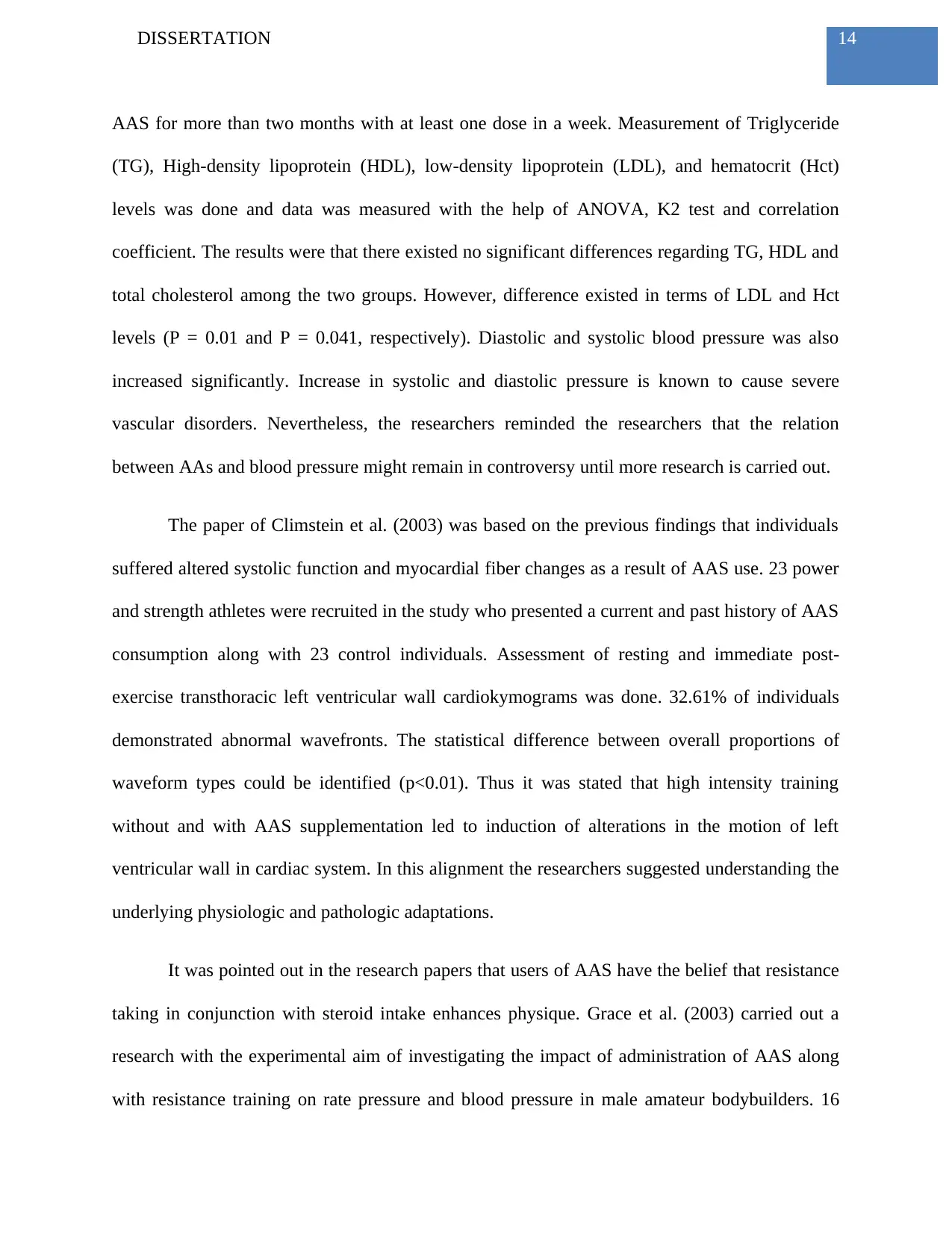
14DISSERTATION
AAS for more than two months with at least one dose in a week. Measurement of Triglyceride
(TG), High-density lipoprotein (HDL), low-density lipoprotein (LDL), and hematocrit (Hct)
levels was done and data was measured with the help of ANOVA, K2 test and correlation
coefficient. The results were that there existed no significant differences regarding TG, HDL and
total cholesterol among the two groups. However, difference existed in terms of LDL and Hct
levels (P = 0.01 and P = 0.041, respectively). Diastolic and systolic blood pressure was also
increased significantly. Increase in systolic and diastolic pressure is known to cause severe
vascular disorders. Nevertheless, the researchers reminded the researchers that the relation
between AAs and blood pressure might remain in controversy until more research is carried out.
The paper of Climstein et al. (2003) was based on the previous findings that individuals
suffered altered systolic function and myocardial fiber changes as a result of AAS use. 23 power
and strength athletes were recruited in the study who presented a current and past history of AAS
consumption along with 23 control individuals. Assessment of resting and immediate post-
exercise transthoracic left ventricular wall cardiokymograms was done. 32.61% of individuals
demonstrated abnormal wavefronts. The statistical difference between overall proportions of
waveform types could be identified (p<0.01). Thus it was stated that high intensity training
without and with AAS supplementation led to induction of alterations in the motion of left
ventricular wall in cardiac system. In this alignment the researchers suggested understanding the
underlying physiologic and pathologic adaptations.
It was pointed out in the research papers that users of AAS have the belief that resistance
taking in conjunction with steroid intake enhances physique. Grace et al. (2003) carried out a
research with the experimental aim of investigating the impact of administration of AAS along
with resistance training on rate pressure and blood pressure in male amateur bodybuilders. 16
AAS for more than two months with at least one dose in a week. Measurement of Triglyceride
(TG), High-density lipoprotein (HDL), low-density lipoprotein (LDL), and hematocrit (Hct)
levels was done and data was measured with the help of ANOVA, K2 test and correlation
coefficient. The results were that there existed no significant differences regarding TG, HDL and
total cholesterol among the two groups. However, difference existed in terms of LDL and Hct
levels (P = 0.01 and P = 0.041, respectively). Diastolic and systolic blood pressure was also
increased significantly. Increase in systolic and diastolic pressure is known to cause severe
vascular disorders. Nevertheless, the researchers reminded the researchers that the relation
between AAs and blood pressure might remain in controversy until more research is carried out.
The paper of Climstein et al. (2003) was based on the previous findings that individuals
suffered altered systolic function and myocardial fiber changes as a result of AAS use. 23 power
and strength athletes were recruited in the study who presented a current and past history of AAS
consumption along with 23 control individuals. Assessment of resting and immediate post-
exercise transthoracic left ventricular wall cardiokymograms was done. 32.61% of individuals
demonstrated abnormal wavefronts. The statistical difference between overall proportions of
waveform types could be identified (p<0.01). Thus it was stated that high intensity training
without and with AAS supplementation led to induction of alterations in the motion of left
ventricular wall in cardiac system. In this alignment the researchers suggested understanding the
underlying physiologic and pathologic adaptations.
It was pointed out in the research papers that users of AAS have the belief that resistance
taking in conjunction with steroid intake enhances physique. Grace et al. (2003) carried out a
research with the experimental aim of investigating the impact of administration of AAS along
with resistance training on rate pressure and blood pressure in male amateur bodybuilders. 16
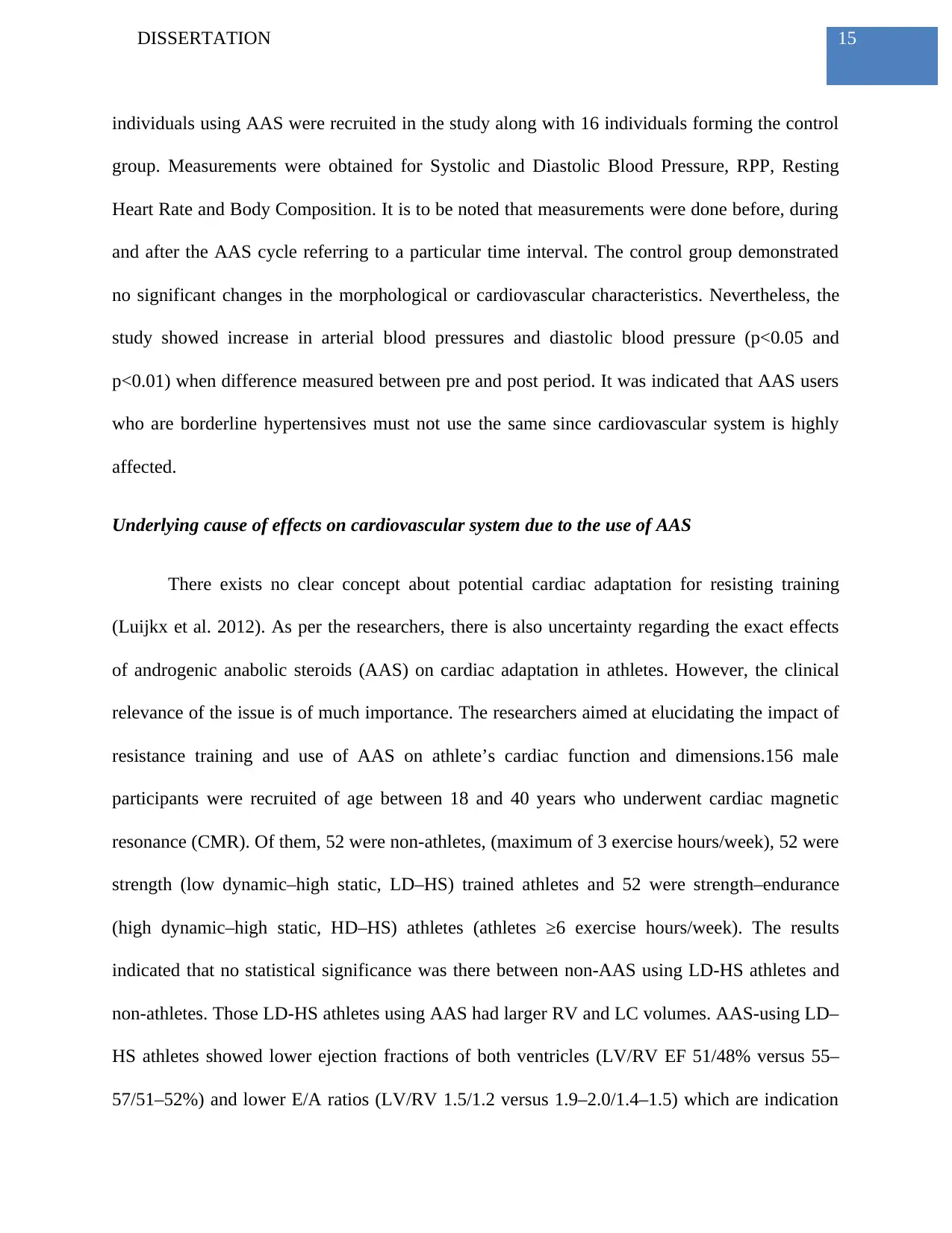
15DISSERTATION
individuals using AAS were recruited in the study along with 16 individuals forming the control
group. Measurements were obtained for Systolic and Diastolic Blood Pressure, RPP, Resting
Heart Rate and Body Composition. It is to be noted that measurements were done before, during
and after the AAS cycle referring to a particular time interval. The control group demonstrated
no significant changes in the morphological or cardiovascular characteristics. Nevertheless, the
study showed increase in arterial blood pressures and diastolic blood pressure (p<0.05 and
p<0.01) when difference measured between pre and post period. It was indicated that AAS users
who are borderline hypertensives must not use the same since cardiovascular system is highly
affected.
Underlying cause of effects on cardiovascular system due to the use of AAS
There exists no clear concept about potential cardiac adaptation for resisting training
(Luijkx et al. 2012). As per the researchers, there is also uncertainty regarding the exact effects
of androgenic anabolic steroids (AAS) on cardiac adaptation in athletes. However, the clinical
relevance of the issue is of much importance. The researchers aimed at elucidating the impact of
resistance training and use of AAS on athlete’s cardiac function and dimensions.156 male
participants were recruited of age between 18 and 40 years who underwent cardiac magnetic
resonance (CMR). Of them, 52 were non-athletes, (maximum of 3 exercise hours/week), 52 were
strength (low dynamic–high static, LD–HS) trained athletes and 52 were strength–endurance
(high dynamic–high static, HD–HS) athletes (athletes ≥6 exercise hours/week). The results
indicated that no statistical significance was there between non-AAS using LD-HS athletes and
non-athletes. Those LD-HS athletes using AAS had larger RV and LC volumes. AAS-using LD–
HS athletes showed lower ejection fractions of both ventricles (LV/RV EF 51/48% versus 55–
57/51–52%) and lower E/A ratios (LV/RV 1.5/1.2 versus 1.9–2.0/1.4–1.5) which are indication
individuals using AAS were recruited in the study along with 16 individuals forming the control
group. Measurements were obtained for Systolic and Diastolic Blood Pressure, RPP, Resting
Heart Rate and Body Composition. It is to be noted that measurements were done before, during
and after the AAS cycle referring to a particular time interval. The control group demonstrated
no significant changes in the morphological or cardiovascular characteristics. Nevertheless, the
study showed increase in arterial blood pressures and diastolic blood pressure (p<0.05 and
p<0.01) when difference measured between pre and post period. It was indicated that AAS users
who are borderline hypertensives must not use the same since cardiovascular system is highly
affected.
Underlying cause of effects on cardiovascular system due to the use of AAS
There exists no clear concept about potential cardiac adaptation for resisting training
(Luijkx et al. 2012). As per the researchers, there is also uncertainty regarding the exact effects
of androgenic anabolic steroids (AAS) on cardiac adaptation in athletes. However, the clinical
relevance of the issue is of much importance. The researchers aimed at elucidating the impact of
resistance training and use of AAS on athlete’s cardiac function and dimensions.156 male
participants were recruited of age between 18 and 40 years who underwent cardiac magnetic
resonance (CMR). Of them, 52 were non-athletes, (maximum of 3 exercise hours/week), 52 were
strength (low dynamic–high static, LD–HS) trained athletes and 52 were strength–endurance
(high dynamic–high static, HD–HS) athletes (athletes ≥6 exercise hours/week). The results
indicated that no statistical significance was there between non-AAS using LD-HS athletes and
non-athletes. Those LD-HS athletes using AAS had larger RV and LC volumes. AAS-using LD–
HS athletes showed lower ejection fractions of both ventricles (LV/RV EF 51/48% versus 55–
57/51–52%) and lower E/A ratios (LV/RV 1.5/1.2 versus 1.9–2.0/1.4–1.5) which are indication
Secure Best Marks with AI Grader
Need help grading? Try our AI Grader for instant feedback on your assignments.
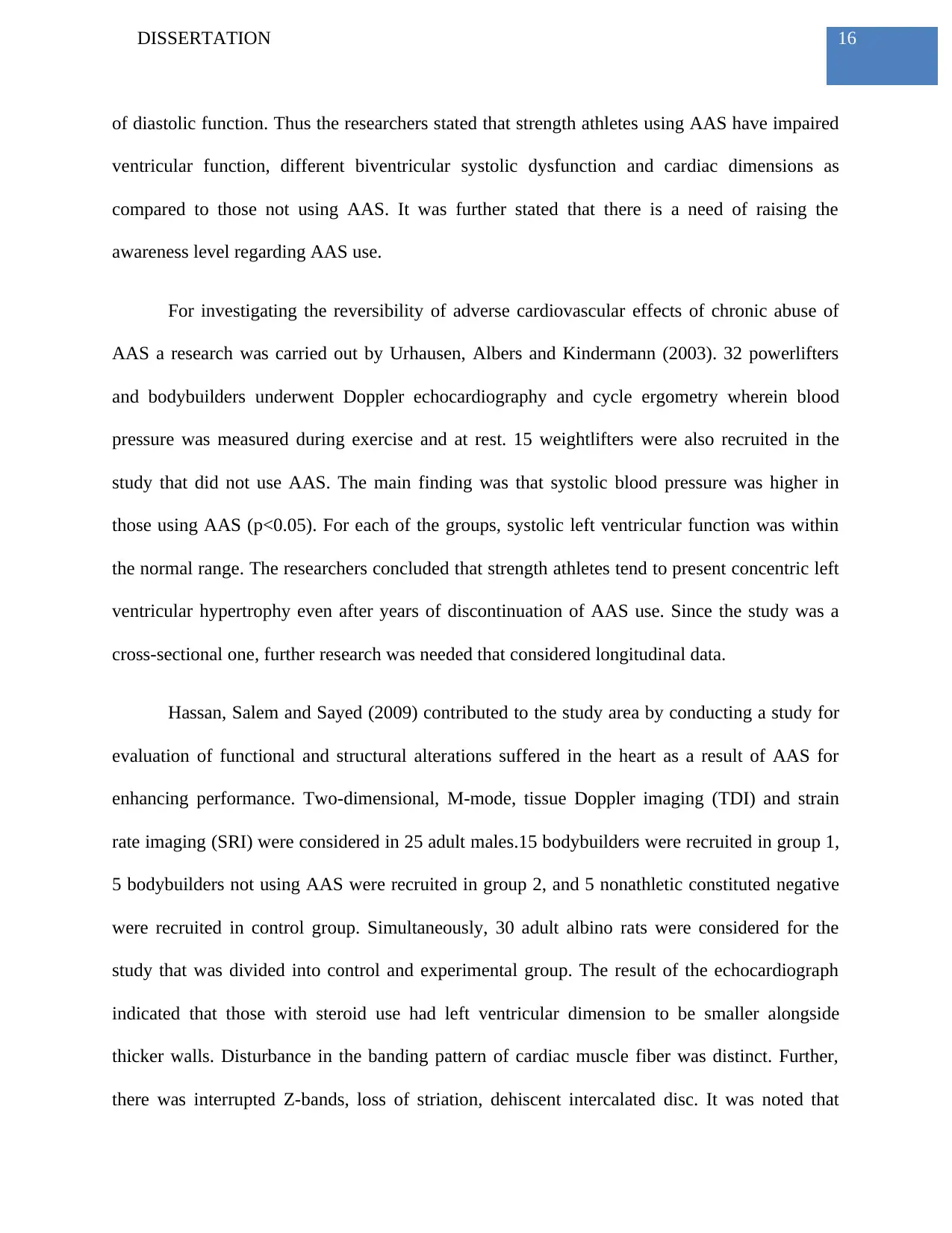
16DISSERTATION
of diastolic function. Thus the researchers stated that strength athletes using AAS have impaired
ventricular function, different biventricular systolic dysfunction and cardiac dimensions as
compared to those not using AAS. It was further stated that there is a need of raising the
awareness level regarding AAS use.
For investigating the reversibility of adverse cardiovascular effects of chronic abuse of
AAS a research was carried out by Urhausen, Albers and Kindermann (2003). 32 powerlifters
and bodybuilders underwent Doppler echocardiography and cycle ergometry wherein blood
pressure was measured during exercise and at rest. 15 weightlifters were also recruited in the
study that did not use AAS. The main finding was that systolic blood pressure was higher in
those using AAS (p<0.05). For each of the groups, systolic left ventricular function was within
the normal range. The researchers concluded that strength athletes tend to present concentric left
ventricular hypertrophy even after years of discontinuation of AAS use. Since the study was a
cross-sectional one, further research was needed that considered longitudinal data.
Hassan, Salem and Sayed (2009) contributed to the study area by conducting a study for
evaluation of functional and structural alterations suffered in the heart as a result of AAS for
enhancing performance. Two-dimensional, M-mode, tissue Doppler imaging (TDI) and strain
rate imaging (SRI) were considered in 25 adult males.15 bodybuilders were recruited in group 1,
5 bodybuilders not using AAS were recruited in group 2, and 5 nonathletic constituted negative
were recruited in control group. Simultaneously, 30 adult albino rats were considered for the
study that was divided into control and experimental group. The result of the echocardiograph
indicated that those with steroid use had left ventricular dimension to be smaller alongside
thicker walls. Disturbance in the banding pattern of cardiac muscle fiber was distinct. Further,
there was interrupted Z-bands, loss of striation, dehiscent intercalated disc. It was noted that
of diastolic function. Thus the researchers stated that strength athletes using AAS have impaired
ventricular function, different biventricular systolic dysfunction and cardiac dimensions as
compared to those not using AAS. It was further stated that there is a need of raising the
awareness level regarding AAS use.
For investigating the reversibility of adverse cardiovascular effects of chronic abuse of
AAS a research was carried out by Urhausen, Albers and Kindermann (2003). 32 powerlifters
and bodybuilders underwent Doppler echocardiography and cycle ergometry wherein blood
pressure was measured during exercise and at rest. 15 weightlifters were also recruited in the
study that did not use AAS. The main finding was that systolic blood pressure was higher in
those using AAS (p<0.05). For each of the groups, systolic left ventricular function was within
the normal range. The researchers concluded that strength athletes tend to present concentric left
ventricular hypertrophy even after years of discontinuation of AAS use. Since the study was a
cross-sectional one, further research was needed that considered longitudinal data.
Hassan, Salem and Sayed (2009) contributed to the study area by conducting a study for
evaluation of functional and structural alterations suffered in the heart as a result of AAS for
enhancing performance. Two-dimensional, M-mode, tissue Doppler imaging (TDI) and strain
rate imaging (SRI) were considered in 25 adult males.15 bodybuilders were recruited in group 1,
5 bodybuilders not using AAS were recruited in group 2, and 5 nonathletic constituted negative
were recruited in control group. Simultaneously, 30 adult albino rats were considered for the
study that was divided into control and experimental group. The result of the echocardiograph
indicated that those with steroid use had left ventricular dimension to be smaller alongside
thicker walls. Disturbance in the banding pattern of cardiac muscle fiber was distinct. Further,
there was interrupted Z-bands, loss of striation, dehiscent intercalated disc. It was noted that
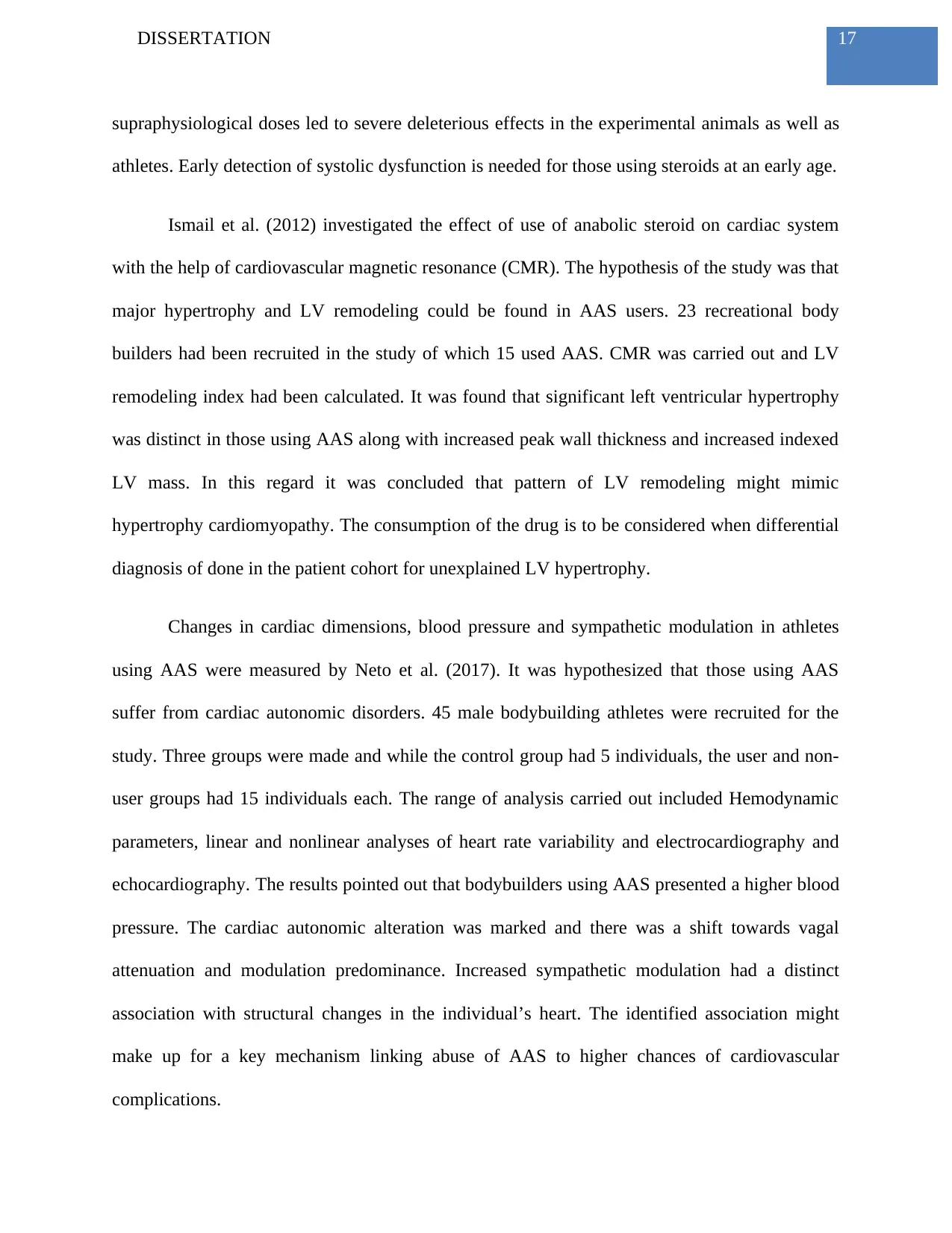
17DISSERTATION
supraphysiological doses led to severe deleterious effects in the experimental animals as well as
athletes. Early detection of systolic dysfunction is needed for those using steroids at an early age.
Ismail et al. (2012) investigated the effect of use of anabolic steroid on cardiac system
with the help of cardiovascular magnetic resonance (CMR). The hypothesis of the study was that
major hypertrophy and LV remodeling could be found in AAS users. 23 recreational body
builders had been recruited in the study of which 15 used AAS. CMR was carried out and LV
remodeling index had been calculated. It was found that significant left ventricular hypertrophy
was distinct in those using AAS along with increased peak wall thickness and increased indexed
LV mass. In this regard it was concluded that pattern of LV remodeling might mimic
hypertrophy cardiomyopathy. The consumption of the drug is to be considered when differential
diagnosis of done in the patient cohort for unexplained LV hypertrophy.
Changes in cardiac dimensions, blood pressure and sympathetic modulation in athletes
using AAS were measured by Neto et al. (2017). It was hypothesized that those using AAS
suffer from cardiac autonomic disorders. 45 male bodybuilding athletes were recruited for the
study. Three groups were made and while the control group had 5 individuals, the user and non-
user groups had 15 individuals each. The range of analysis carried out included Hemodynamic
parameters, linear and nonlinear analyses of heart rate variability and electrocardiography and
echocardiography. The results pointed out that bodybuilders using AAS presented a higher blood
pressure. The cardiac autonomic alteration was marked and there was a shift towards vagal
attenuation and modulation predominance. Increased sympathetic modulation had a distinct
association with structural changes in the individual’s heart. The identified association might
make up for a key mechanism linking abuse of AAS to higher chances of cardiovascular
complications.
supraphysiological doses led to severe deleterious effects in the experimental animals as well as
athletes. Early detection of systolic dysfunction is needed for those using steroids at an early age.
Ismail et al. (2012) investigated the effect of use of anabolic steroid on cardiac system
with the help of cardiovascular magnetic resonance (CMR). The hypothesis of the study was that
major hypertrophy and LV remodeling could be found in AAS users. 23 recreational body
builders had been recruited in the study of which 15 used AAS. CMR was carried out and LV
remodeling index had been calculated. It was found that significant left ventricular hypertrophy
was distinct in those using AAS along with increased peak wall thickness and increased indexed
LV mass. In this regard it was concluded that pattern of LV remodeling might mimic
hypertrophy cardiomyopathy. The consumption of the drug is to be considered when differential
diagnosis of done in the patient cohort for unexplained LV hypertrophy.
Changes in cardiac dimensions, blood pressure and sympathetic modulation in athletes
using AAS were measured by Neto et al. (2017). It was hypothesized that those using AAS
suffer from cardiac autonomic disorders. 45 male bodybuilding athletes were recruited for the
study. Three groups were made and while the control group had 5 individuals, the user and non-
user groups had 15 individuals each. The range of analysis carried out included Hemodynamic
parameters, linear and nonlinear analyses of heart rate variability and electrocardiography and
echocardiography. The results pointed out that bodybuilders using AAS presented a higher blood
pressure. The cardiac autonomic alteration was marked and there was a shift towards vagal
attenuation and modulation predominance. Increased sympathetic modulation had a distinct
association with structural changes in the individual’s heart. The identified association might
make up for a key mechanism linking abuse of AAS to higher chances of cardiovascular
complications.
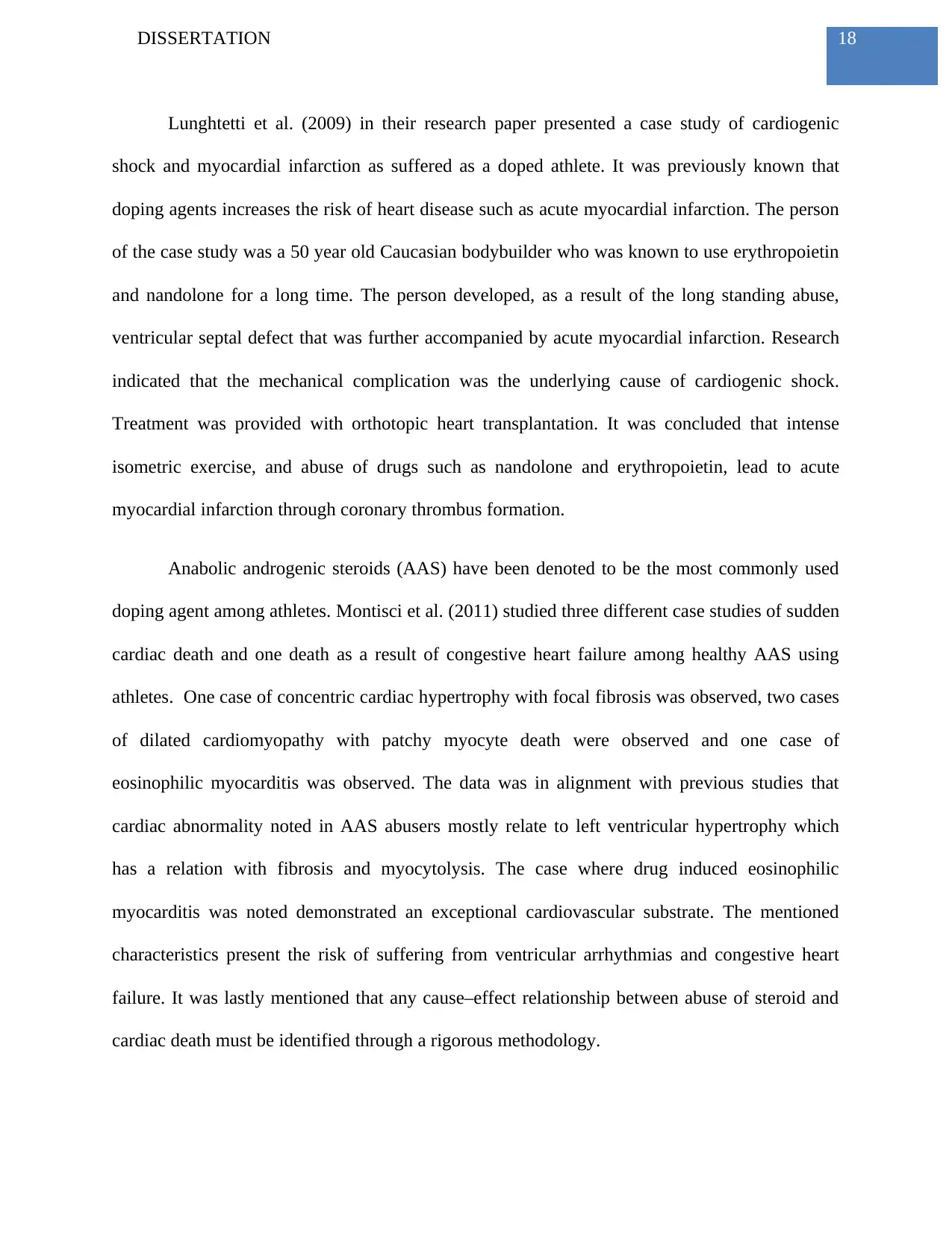
18DISSERTATION
Lunghtetti et al. (2009) in their research paper presented a case study of cardiogenic
shock and myocardial infarction as suffered as a doped athlete. It was previously known that
doping agents increases the risk of heart disease such as acute myocardial infarction. The person
of the case study was a 50 year old Caucasian bodybuilder who was known to use erythropoietin
and nandolone for a long time. The person developed, as a result of the long standing abuse,
ventricular septal defect that was further accompanied by acute myocardial infarction. Research
indicated that the mechanical complication was the underlying cause of cardiogenic shock.
Treatment was provided with orthotopic heart transplantation. It was concluded that intense
isometric exercise, and abuse of drugs such as nandolone and erythropoietin, lead to acute
myocardial infarction through coronary thrombus formation.
Anabolic androgenic steroids (AAS) have been denoted to be the most commonly used
doping agent among athletes. Montisci et al. (2011) studied three different case studies of sudden
cardiac death and one death as a result of congestive heart failure among healthy AAS using
athletes. One case of concentric cardiac hypertrophy with focal fibrosis was observed, two cases
of dilated cardiomyopathy with patchy myocyte death were observed and one case of
eosinophilic myocarditis was observed. The data was in alignment with previous studies that
cardiac abnormality noted in AAS abusers mostly relate to left ventricular hypertrophy which
has a relation with fibrosis and myocytolysis. The case where drug induced eosinophilic
myocarditis was noted demonstrated an exceptional cardiovascular substrate. The mentioned
characteristics present the risk of suffering from ventricular arrhythmias and congestive heart
failure. It was lastly mentioned that any cause–effect relationship between abuse of steroid and
cardiac death must be identified through a rigorous methodology.
Lunghtetti et al. (2009) in their research paper presented a case study of cardiogenic
shock and myocardial infarction as suffered as a doped athlete. It was previously known that
doping agents increases the risk of heart disease such as acute myocardial infarction. The person
of the case study was a 50 year old Caucasian bodybuilder who was known to use erythropoietin
and nandolone for a long time. The person developed, as a result of the long standing abuse,
ventricular septal defect that was further accompanied by acute myocardial infarction. Research
indicated that the mechanical complication was the underlying cause of cardiogenic shock.
Treatment was provided with orthotopic heart transplantation. It was concluded that intense
isometric exercise, and abuse of drugs such as nandolone and erythropoietin, lead to acute
myocardial infarction through coronary thrombus formation.
Anabolic androgenic steroids (AAS) have been denoted to be the most commonly used
doping agent among athletes. Montisci et al. (2011) studied three different case studies of sudden
cardiac death and one death as a result of congestive heart failure among healthy AAS using
athletes. One case of concentric cardiac hypertrophy with focal fibrosis was observed, two cases
of dilated cardiomyopathy with patchy myocyte death were observed and one case of
eosinophilic myocarditis was observed. The data was in alignment with previous studies that
cardiac abnormality noted in AAS abusers mostly relate to left ventricular hypertrophy which
has a relation with fibrosis and myocytolysis. The case where drug induced eosinophilic
myocarditis was noted demonstrated an exceptional cardiovascular substrate. The mentioned
characteristics present the risk of suffering from ventricular arrhythmias and congestive heart
failure. It was lastly mentioned that any cause–effect relationship between abuse of steroid and
cardiac death must be identified through a rigorous methodology.
Paraphrase This Document
Need a fresh take? Get an instant paraphrase of this document with our AI Paraphraser
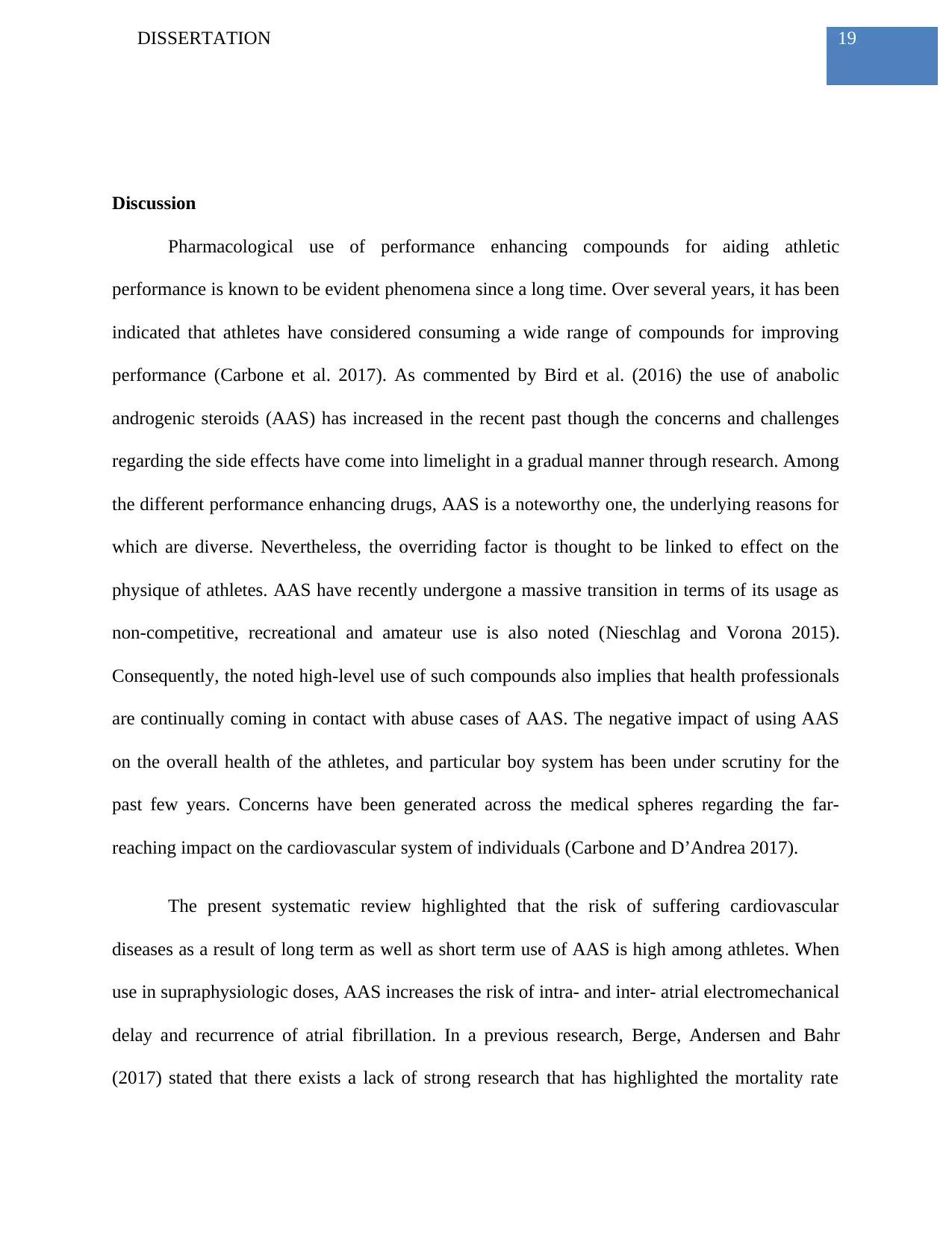
19DISSERTATION
Discussion
Pharmacological use of performance enhancing compounds for aiding athletic
performance is known to be evident phenomena since a long time. Over several years, it has been
indicated that athletes have considered consuming a wide range of compounds for improving
performance (Carbone et al. 2017). As commented by Bird et al. (2016) the use of anabolic
androgenic steroids (AAS) has increased in the recent past though the concerns and challenges
regarding the side effects have come into limelight in a gradual manner through research. Among
the different performance enhancing drugs, AAS is a noteworthy one, the underlying reasons for
which are diverse. Nevertheless, the overriding factor is thought to be linked to effect on the
physique of athletes. AAS have recently undergone a massive transition in terms of its usage as
non-competitive, recreational and amateur use is also noted (Nieschlag and Vorona 2015).
Consequently, the noted high-level use of such compounds also implies that health professionals
are continually coming in contact with abuse cases of AAS. The negative impact of using AAS
on the overall health of the athletes, and particular boy system has been under scrutiny for the
past few years. Concerns have been generated across the medical spheres regarding the far-
reaching impact on the cardiovascular system of individuals (Carbone and D’Andrea 2017).
The present systematic review highlighted that the risk of suffering cardiovascular
diseases as a result of long term as well as short term use of AAS is high among athletes. When
use in supraphysiologic doses, AAS increases the risk of intra- and inter- atrial electromechanical
delay and recurrence of atrial fibrillation. In a previous research, Berge, Andersen and Bahr
(2017) stated that there exists a lack of strong research that has highlighted the mortality rate
Discussion
Pharmacological use of performance enhancing compounds for aiding athletic
performance is known to be evident phenomena since a long time. Over several years, it has been
indicated that athletes have considered consuming a wide range of compounds for improving
performance (Carbone et al. 2017). As commented by Bird et al. (2016) the use of anabolic
androgenic steroids (AAS) has increased in the recent past though the concerns and challenges
regarding the side effects have come into limelight in a gradual manner through research. Among
the different performance enhancing drugs, AAS is a noteworthy one, the underlying reasons for
which are diverse. Nevertheless, the overriding factor is thought to be linked to effect on the
physique of athletes. AAS have recently undergone a massive transition in terms of its usage as
non-competitive, recreational and amateur use is also noted (Nieschlag and Vorona 2015).
Consequently, the noted high-level use of such compounds also implies that health professionals
are continually coming in contact with abuse cases of AAS. The negative impact of using AAS
on the overall health of the athletes, and particular boy system has been under scrutiny for the
past few years. Concerns have been generated across the medical spheres regarding the far-
reaching impact on the cardiovascular system of individuals (Carbone and D’Andrea 2017).
The present systematic review highlighted that the risk of suffering cardiovascular
diseases as a result of long term as well as short term use of AAS is high among athletes. When
use in supraphysiologic doses, AAS increases the risk of intra- and inter- atrial electromechanical
delay and recurrence of atrial fibrillation. In a previous research, Berge, Andersen and Bahr
(2017) stated that there exists a lack of strong research that has highlighted the mortality rate
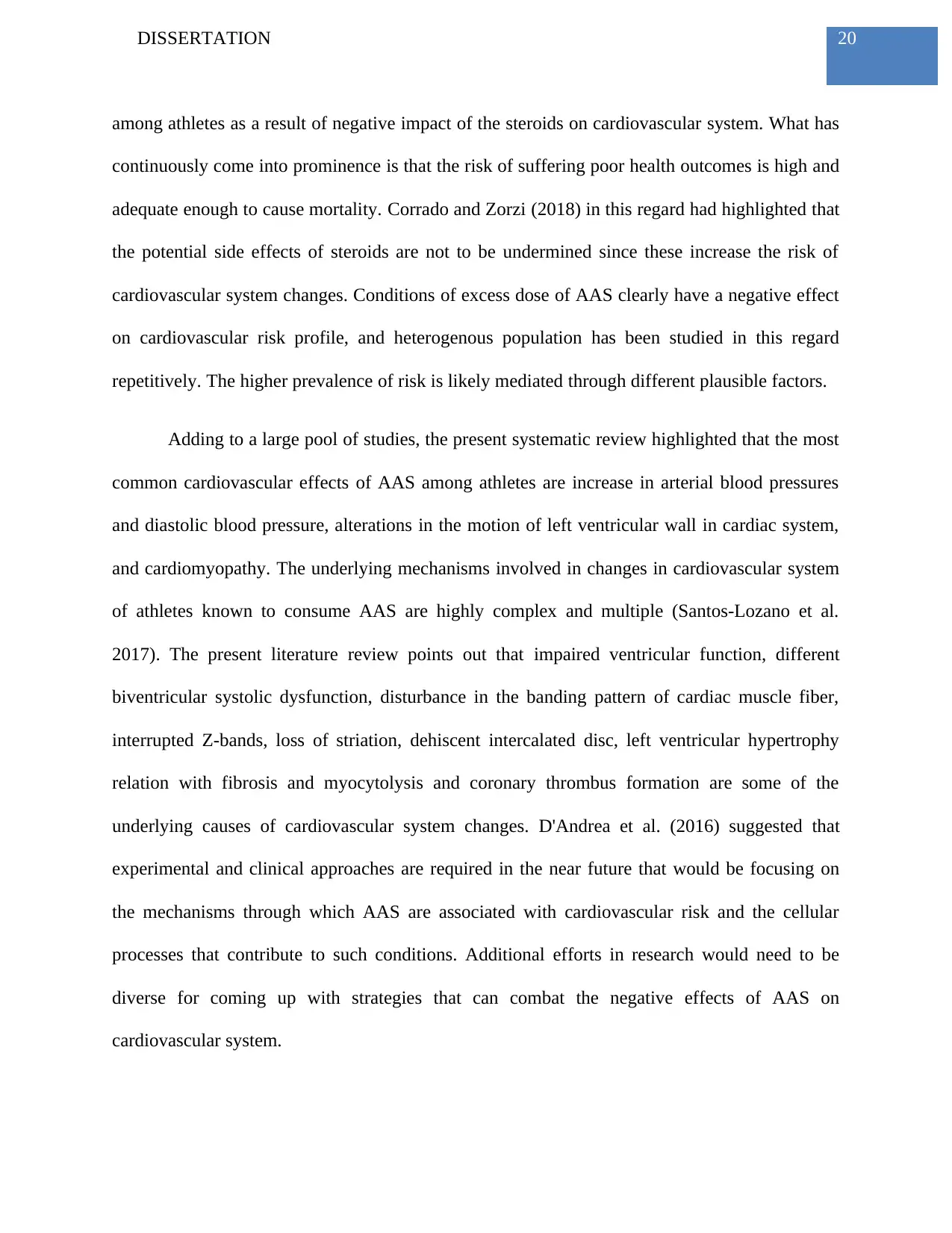
20DISSERTATION
among athletes as a result of negative impact of the steroids on cardiovascular system. What has
continuously come into prominence is that the risk of suffering poor health outcomes is high and
adequate enough to cause mortality. Corrado and Zorzi (2018) in this regard had highlighted that
the potential side effects of steroids are not to be undermined since these increase the risk of
cardiovascular system changes. Conditions of excess dose of AAS clearly have a negative effect
on cardiovascular risk profile, and heterogenous population has been studied in this regard
repetitively. The higher prevalence of risk is likely mediated through different plausible factors.
Adding to a large pool of studies, the present systematic review highlighted that the most
common cardiovascular effects of AAS among athletes are increase in arterial blood pressures
and diastolic blood pressure, alterations in the motion of left ventricular wall in cardiac system,
and cardiomyopathy. The underlying mechanisms involved in changes in cardiovascular system
of athletes known to consume AAS are highly complex and multiple (Santos-Lozano et al.
2017). The present literature review points out that impaired ventricular function, different
biventricular systolic dysfunction, disturbance in the banding pattern of cardiac muscle fiber,
interrupted Z-bands, loss of striation, dehiscent intercalated disc, left ventricular hypertrophy
relation with fibrosis and myocytolysis and coronary thrombus formation are some of the
underlying causes of cardiovascular system changes. D'Andrea et al. (2016) suggested that
experimental and clinical approaches are required in the near future that would be focusing on
the mechanisms through which AAS are associated with cardiovascular risk and the cellular
processes that contribute to such conditions. Additional efforts in research would need to be
diverse for coming up with strategies that can combat the negative effects of AAS on
cardiovascular system.
among athletes as a result of negative impact of the steroids on cardiovascular system. What has
continuously come into prominence is that the risk of suffering poor health outcomes is high and
adequate enough to cause mortality. Corrado and Zorzi (2018) in this regard had highlighted that
the potential side effects of steroids are not to be undermined since these increase the risk of
cardiovascular system changes. Conditions of excess dose of AAS clearly have a negative effect
on cardiovascular risk profile, and heterogenous population has been studied in this regard
repetitively. The higher prevalence of risk is likely mediated through different plausible factors.
Adding to a large pool of studies, the present systematic review highlighted that the most
common cardiovascular effects of AAS among athletes are increase in arterial blood pressures
and diastolic blood pressure, alterations in the motion of left ventricular wall in cardiac system,
and cardiomyopathy. The underlying mechanisms involved in changes in cardiovascular system
of athletes known to consume AAS are highly complex and multiple (Santos-Lozano et al.
2017). The present literature review points out that impaired ventricular function, different
biventricular systolic dysfunction, disturbance in the banding pattern of cardiac muscle fiber,
interrupted Z-bands, loss of striation, dehiscent intercalated disc, left ventricular hypertrophy
relation with fibrosis and myocytolysis and coronary thrombus formation are some of the
underlying causes of cardiovascular system changes. D'Andrea et al. (2016) suggested that
experimental and clinical approaches are required in the near future that would be focusing on
the mechanisms through which AAS are associated with cardiovascular risk and the cellular
processes that contribute to such conditions. Additional efforts in research would need to be
diverse for coming up with strategies that can combat the negative effects of AAS on
cardiovascular system.
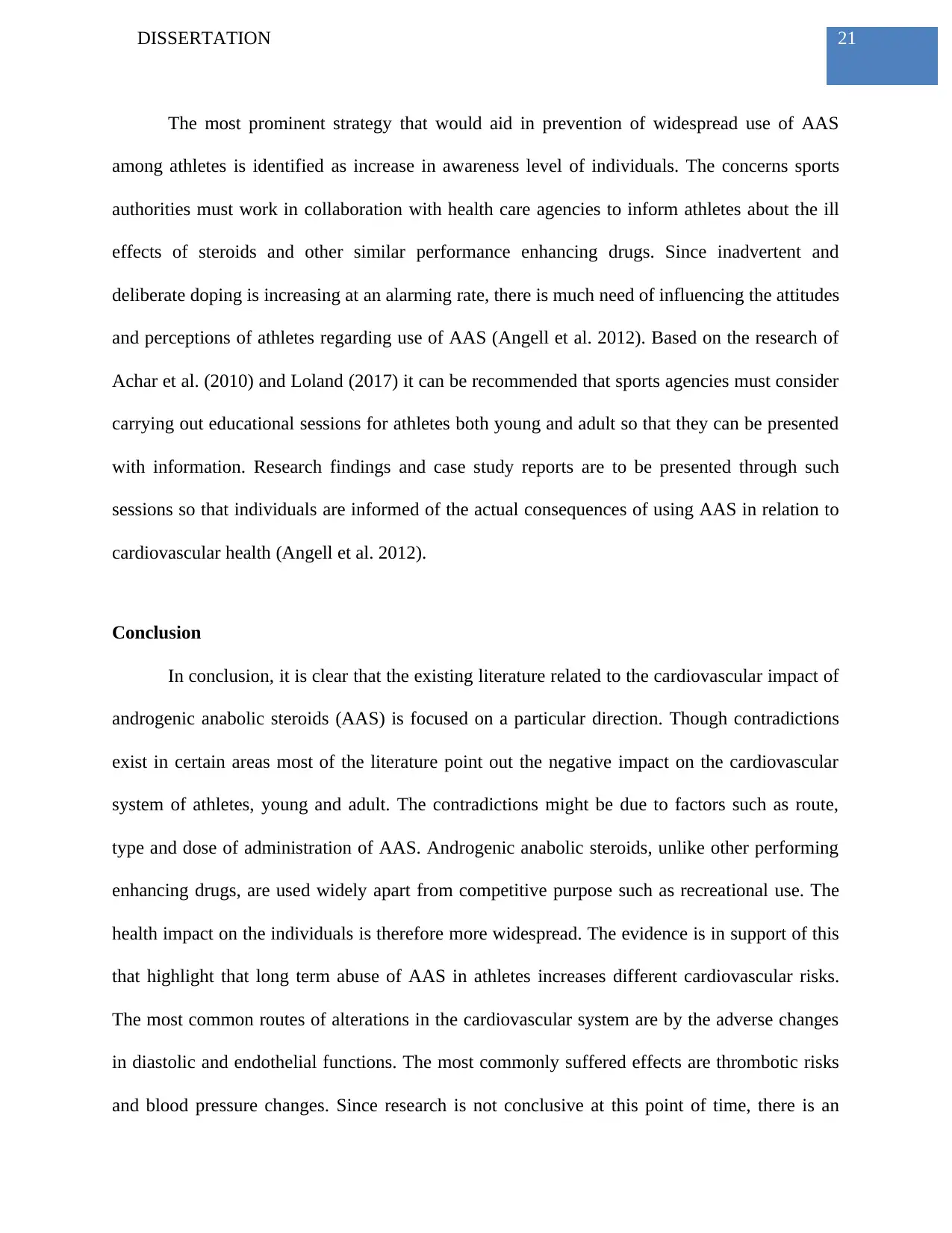
21DISSERTATION
The most prominent strategy that would aid in prevention of widespread use of AAS
among athletes is identified as increase in awareness level of individuals. The concerns sports
authorities must work in collaboration with health care agencies to inform athletes about the ill
effects of steroids and other similar performance enhancing drugs. Since inadvertent and
deliberate doping is increasing at an alarming rate, there is much need of influencing the attitudes
and perceptions of athletes regarding use of AAS (Angell et al. 2012). Based on the research of
Achar et al. (2010) and Loland (2017) it can be recommended that sports agencies must consider
carrying out educational sessions for athletes both young and adult so that they can be presented
with information. Research findings and case study reports are to be presented through such
sessions so that individuals are informed of the actual consequences of using AAS in relation to
cardiovascular health (Angell et al. 2012).
Conclusion
In conclusion, it is clear that the existing literature related to the cardiovascular impact of
androgenic anabolic steroids (AAS) is focused on a particular direction. Though contradictions
exist in certain areas most of the literature point out the negative impact on the cardiovascular
system of athletes, young and adult. The contradictions might be due to factors such as route,
type and dose of administration of AAS. Androgenic anabolic steroids, unlike other performing
enhancing drugs, are used widely apart from competitive purpose such as recreational use. The
health impact on the individuals is therefore more widespread. The evidence is in support of this
that highlight that long term abuse of AAS in athletes increases different cardiovascular risks.
The most common routes of alterations in the cardiovascular system are by the adverse changes
in diastolic and endothelial functions. The most commonly suffered effects are thrombotic risks
and blood pressure changes. Since research is not conclusive at this point of time, there is an
The most prominent strategy that would aid in prevention of widespread use of AAS
among athletes is identified as increase in awareness level of individuals. The concerns sports
authorities must work in collaboration with health care agencies to inform athletes about the ill
effects of steroids and other similar performance enhancing drugs. Since inadvertent and
deliberate doping is increasing at an alarming rate, there is much need of influencing the attitudes
and perceptions of athletes regarding use of AAS (Angell et al. 2012). Based on the research of
Achar et al. (2010) and Loland (2017) it can be recommended that sports agencies must consider
carrying out educational sessions for athletes both young and adult so that they can be presented
with information. Research findings and case study reports are to be presented through such
sessions so that individuals are informed of the actual consequences of using AAS in relation to
cardiovascular health (Angell et al. 2012).
Conclusion
In conclusion, it is clear that the existing literature related to the cardiovascular impact of
androgenic anabolic steroids (AAS) is focused on a particular direction. Though contradictions
exist in certain areas most of the literature point out the negative impact on the cardiovascular
system of athletes, young and adult. The contradictions might be due to factors such as route,
type and dose of administration of AAS. Androgenic anabolic steroids, unlike other performing
enhancing drugs, are used widely apart from competitive purpose such as recreational use. The
health impact on the individuals is therefore more widespread. The evidence is in support of this
that highlight that long term abuse of AAS in athletes increases different cardiovascular risks.
The most common routes of alterations in the cardiovascular system are by the adverse changes
in diastolic and endothelial functions. The most commonly suffered effects are thrombotic risks
and blood pressure changes. Since research is not conclusive at this point of time, there is an
Secure Best Marks with AI Grader
Need help grading? Try our AI Grader for instant feedback on your assignments.
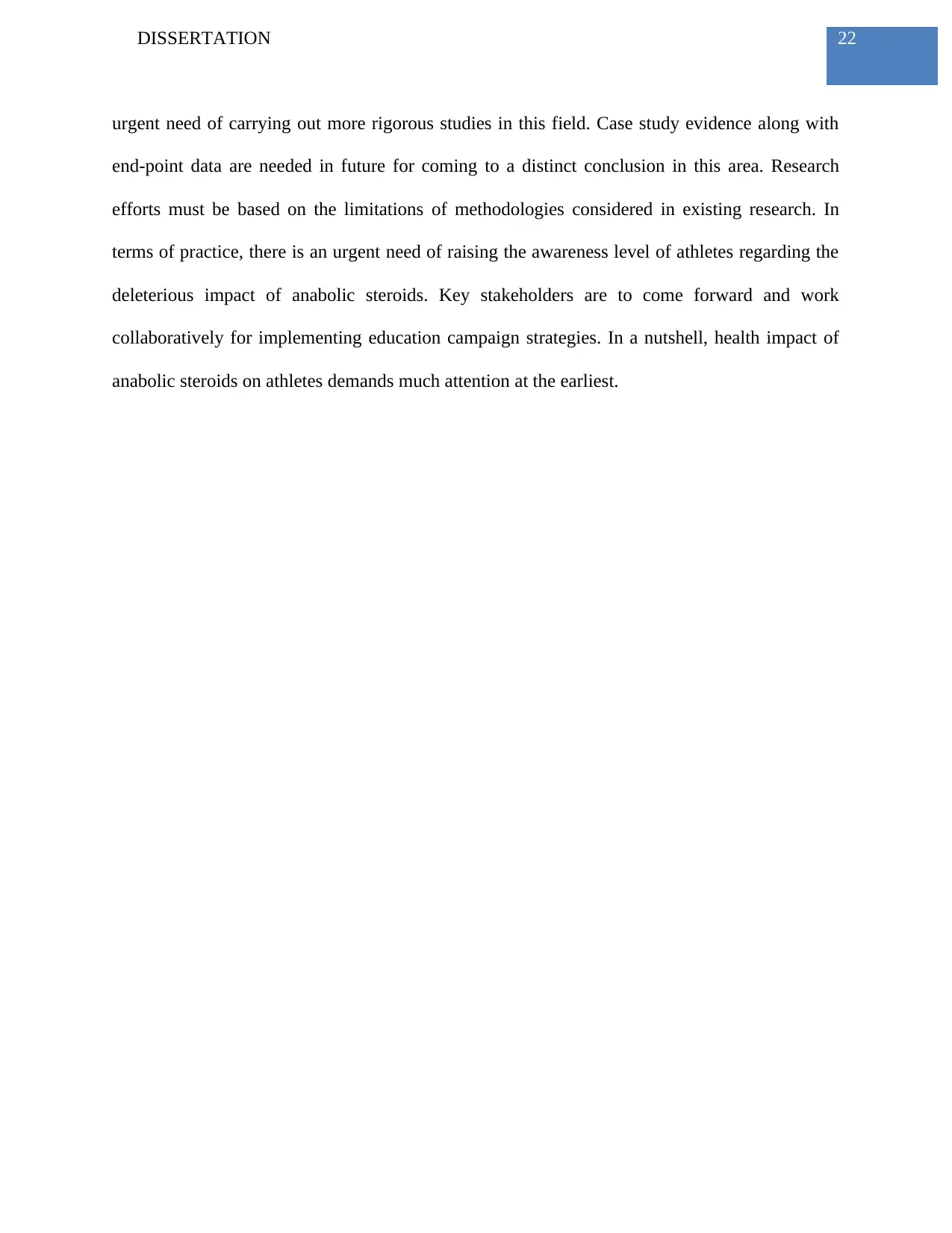
22DISSERTATION
urgent need of carrying out more rigorous studies in this field. Case study evidence along with
end-point data are needed in future for coming to a distinct conclusion in this area. Research
efforts must be based on the limitations of methodologies considered in existing research. In
terms of practice, there is an urgent need of raising the awareness level of athletes regarding the
deleterious impact of anabolic steroids. Key stakeholders are to come forward and work
collaboratively for implementing education campaign strategies. In a nutshell, health impact of
anabolic steroids on athletes demands much attention at the earliest.
urgent need of carrying out more rigorous studies in this field. Case study evidence along with
end-point data are needed in future for coming to a distinct conclusion in this area. Research
efforts must be based on the limitations of methodologies considered in existing research. In
terms of practice, there is an urgent need of raising the awareness level of athletes regarding the
deleterious impact of anabolic steroids. Key stakeholders are to come forward and work
collaboratively for implementing education campaign strategies. In a nutshell, health impact of
anabolic steroids on athletes demands much attention at the earliest.
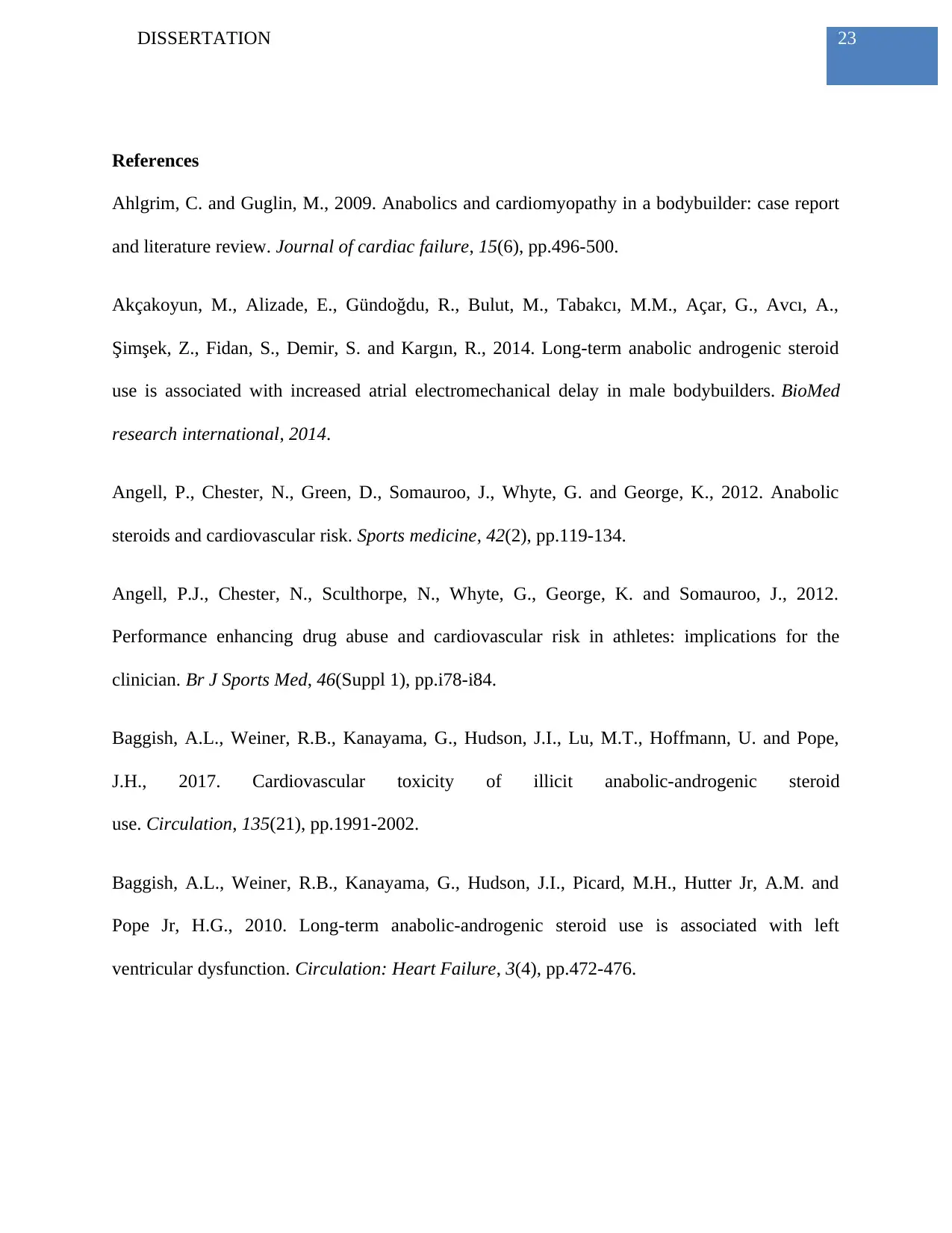
23DISSERTATION
References
Ahlgrim, C. and Guglin, M., 2009. Anabolics and cardiomyopathy in a bodybuilder: case report
and literature review. Journal of cardiac failure, 15(6), pp.496-500.
Akçakoyun, M., Alizade, E., Gündoğdu, R., Bulut, M., Tabakcı, M.M., Açar, G., Avcı, A.,
Şimşek, Z., Fidan, S., Demir, S. and Kargın, R., 2014. Long-term anabolic androgenic steroid
use is associated with increased atrial electromechanical delay in male bodybuilders. BioMed
research international, 2014.
Angell, P., Chester, N., Green, D., Somauroo, J., Whyte, G. and George, K., 2012. Anabolic
steroids and cardiovascular risk. Sports medicine, 42(2), pp.119-134.
Angell, P.J., Chester, N., Sculthorpe, N., Whyte, G., George, K. and Somauroo, J., 2012.
Performance enhancing drug abuse and cardiovascular risk in athletes: implications for the
clinician. Br J Sports Med, 46(Suppl 1), pp.i78-i84.
Baggish, A.L., Weiner, R.B., Kanayama, G., Hudson, J.I., Lu, M.T., Hoffmann, U. and Pope,
J.H., 2017. Cardiovascular toxicity of illicit anabolic-androgenic steroid
use. Circulation, 135(21), pp.1991-2002.
Baggish, A.L., Weiner, R.B., Kanayama, G., Hudson, J.I., Picard, M.H., Hutter Jr, A.M. and
Pope Jr, H.G., 2010. Long-term anabolic-androgenic steroid use is associated with left
ventricular dysfunction. Circulation: Heart Failure, 3(4), pp.472-476.
References
Ahlgrim, C. and Guglin, M., 2009. Anabolics and cardiomyopathy in a bodybuilder: case report
and literature review. Journal of cardiac failure, 15(6), pp.496-500.
Akçakoyun, M., Alizade, E., Gündoğdu, R., Bulut, M., Tabakcı, M.M., Açar, G., Avcı, A.,
Şimşek, Z., Fidan, S., Demir, S. and Kargın, R., 2014. Long-term anabolic androgenic steroid
use is associated with increased atrial electromechanical delay in male bodybuilders. BioMed
research international, 2014.
Angell, P., Chester, N., Green, D., Somauroo, J., Whyte, G. and George, K., 2012. Anabolic
steroids and cardiovascular risk. Sports medicine, 42(2), pp.119-134.
Angell, P.J., Chester, N., Sculthorpe, N., Whyte, G., George, K. and Somauroo, J., 2012.
Performance enhancing drug abuse and cardiovascular risk in athletes: implications for the
clinician. Br J Sports Med, 46(Suppl 1), pp.i78-i84.
Baggish, A.L., Weiner, R.B., Kanayama, G., Hudson, J.I., Lu, M.T., Hoffmann, U. and Pope,
J.H., 2017. Cardiovascular toxicity of illicit anabolic-androgenic steroid
use. Circulation, 135(21), pp.1991-2002.
Baggish, A.L., Weiner, R.B., Kanayama, G., Hudson, J.I., Picard, M.H., Hutter Jr, A.M. and
Pope Jr, H.G., 2010. Long-term anabolic-androgenic steroid use is associated with left
ventricular dysfunction. Circulation: Heart Failure, 3(4), pp.472-476.
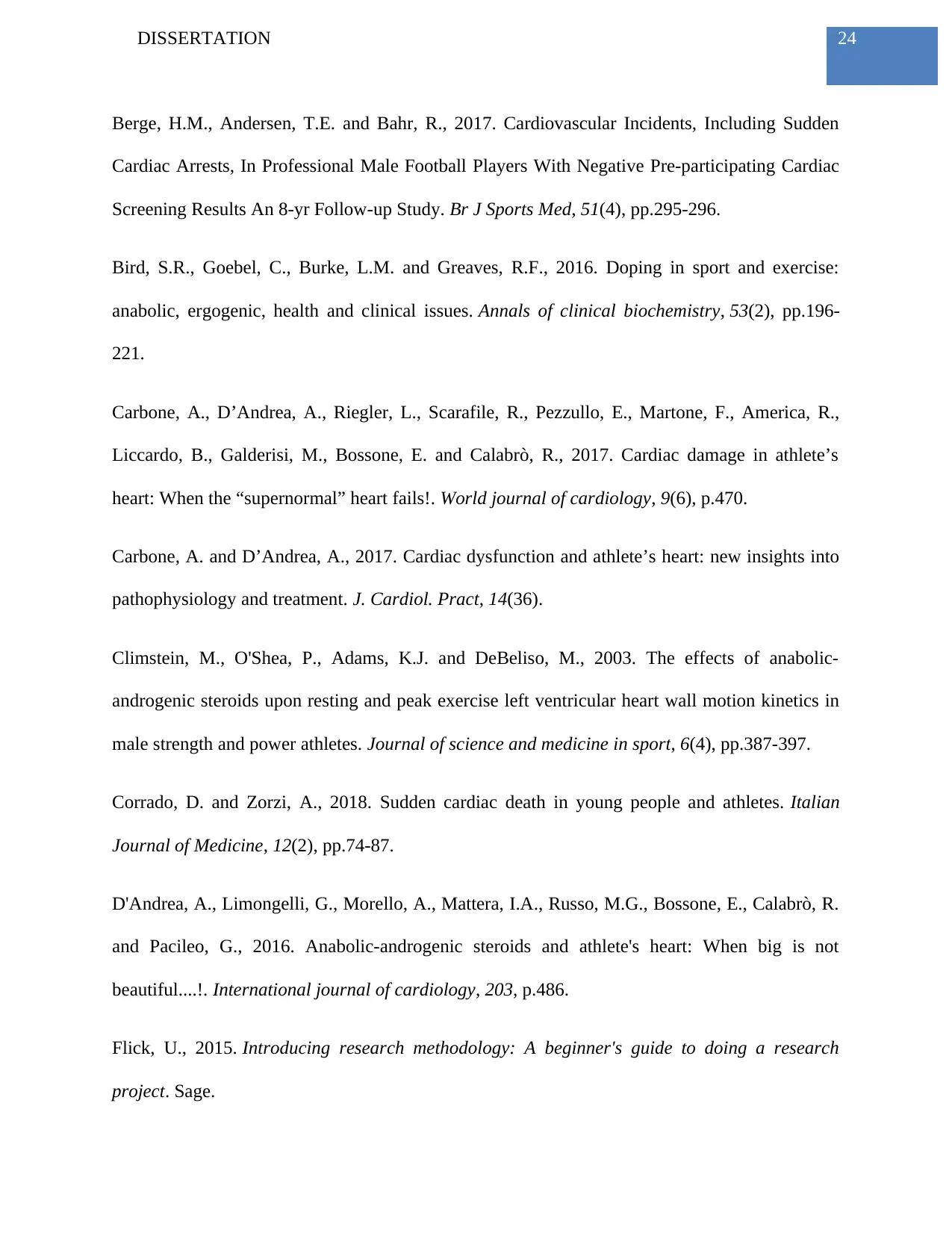
24DISSERTATION
Berge, H.M., Andersen, T.E. and Bahr, R., 2017. Cardiovascular Incidents, Including Sudden
Cardiac Arrests, In Professional Male Football Players With Negative Pre-participating Cardiac
Screening Results An 8-yr Follow-up Study. Br J Sports Med, 51(4), pp.295-296.
Bird, S.R., Goebel, C., Burke, L.M. and Greaves, R.F., 2016. Doping in sport and exercise:
anabolic, ergogenic, health and clinical issues. Annals of clinical biochemistry, 53(2), pp.196-
221.
Carbone, A., D’Andrea, A., Riegler, L., Scarafile, R., Pezzullo, E., Martone, F., America, R.,
Liccardo, B., Galderisi, M., Bossone, E. and Calabrò, R., 2017. Cardiac damage in athlete’s
heart: When the “supernormal” heart fails!. World journal of cardiology, 9(6), p.470.
Carbone, A. and D’Andrea, A., 2017. Cardiac dysfunction and athlete’s heart: new insights into
pathophysiology and treatment. J. Cardiol. Pract, 14(36).
Climstein, M., O'Shea, P., Adams, K.J. and DeBeliso, M., 2003. The effects of anabolic-
androgenic steroids upon resting and peak exercise left ventricular heart wall motion kinetics in
male strength and power athletes. Journal of science and medicine in sport, 6(4), pp.387-397.
Corrado, D. and Zorzi, A., 2018. Sudden cardiac death in young people and athletes. Italian
Journal of Medicine, 12(2), pp.74-87.
D'Andrea, A., Limongelli, G., Morello, A., Mattera, I.A., Russo, M.G., Bossone, E., Calabrò, R.
and Pacileo, G., 2016. Anabolic-androgenic steroids and athlete's heart: When big is not
beautiful....!. International journal of cardiology, 203, p.486.
Flick, U., 2015. Introducing research methodology: A beginner's guide to doing a research
project. Sage.
Berge, H.M., Andersen, T.E. and Bahr, R., 2017. Cardiovascular Incidents, Including Sudden
Cardiac Arrests, In Professional Male Football Players With Negative Pre-participating Cardiac
Screening Results An 8-yr Follow-up Study. Br J Sports Med, 51(4), pp.295-296.
Bird, S.R., Goebel, C., Burke, L.M. and Greaves, R.F., 2016. Doping in sport and exercise:
anabolic, ergogenic, health and clinical issues. Annals of clinical biochemistry, 53(2), pp.196-
221.
Carbone, A., D’Andrea, A., Riegler, L., Scarafile, R., Pezzullo, E., Martone, F., America, R.,
Liccardo, B., Galderisi, M., Bossone, E. and Calabrò, R., 2017. Cardiac damage in athlete’s
heart: When the “supernormal” heart fails!. World journal of cardiology, 9(6), p.470.
Carbone, A. and D’Andrea, A., 2017. Cardiac dysfunction and athlete’s heart: new insights into
pathophysiology and treatment. J. Cardiol. Pract, 14(36).
Climstein, M., O'Shea, P., Adams, K.J. and DeBeliso, M., 2003. The effects of anabolic-
androgenic steroids upon resting and peak exercise left ventricular heart wall motion kinetics in
male strength and power athletes. Journal of science and medicine in sport, 6(4), pp.387-397.
Corrado, D. and Zorzi, A., 2018. Sudden cardiac death in young people and athletes. Italian
Journal of Medicine, 12(2), pp.74-87.
D'Andrea, A., Limongelli, G., Morello, A., Mattera, I.A., Russo, M.G., Bossone, E., Calabrò, R.
and Pacileo, G., 2016. Anabolic-androgenic steroids and athlete's heart: When big is not
beautiful....!. International journal of cardiology, 203, p.486.
Flick, U., 2015. Introducing research methodology: A beginner's guide to doing a research
project. Sage.
Paraphrase This Document
Need a fresh take? Get an instant paraphrase of this document with our AI Paraphraser
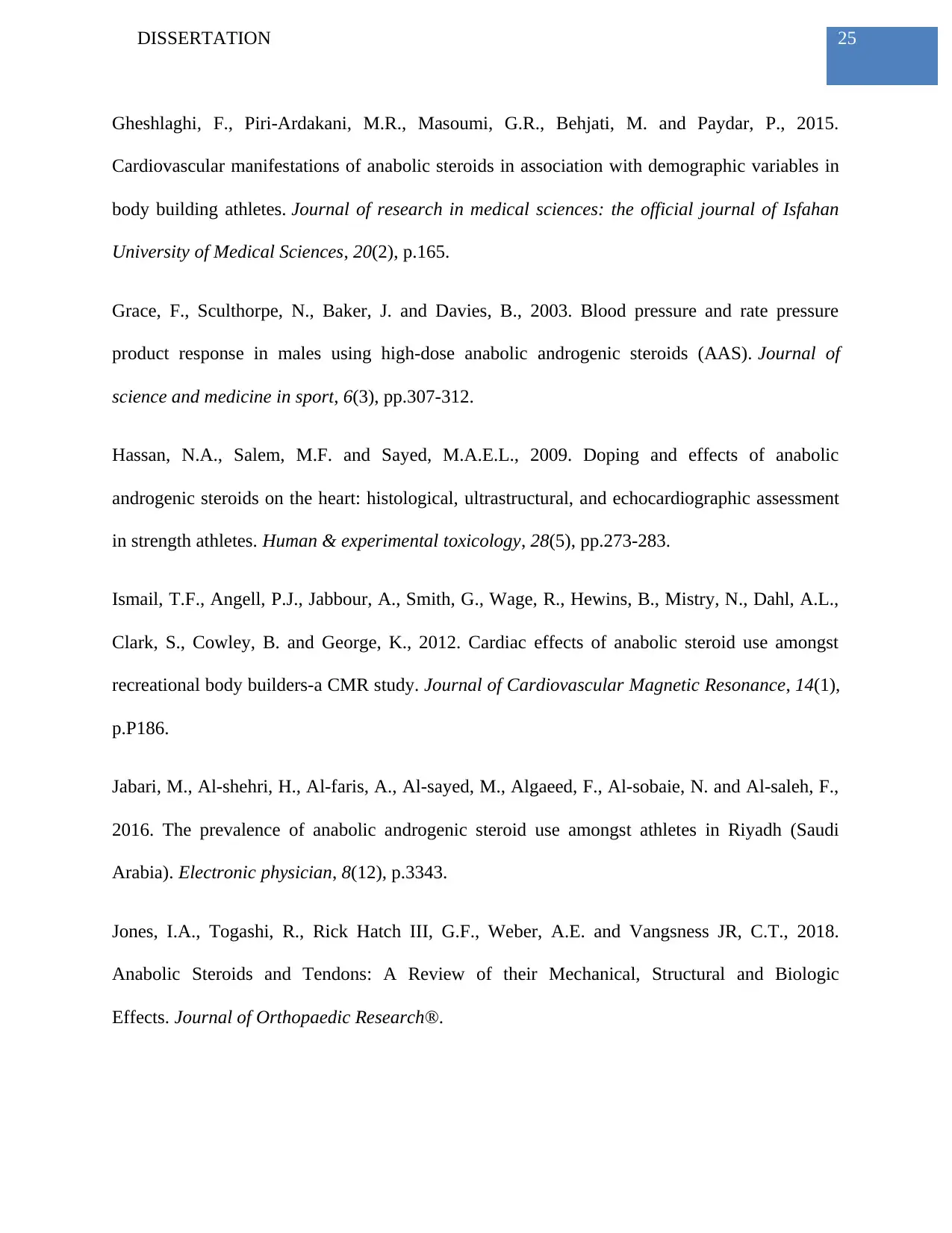
25DISSERTATION
Gheshlaghi, F., Piri-Ardakani, M.R., Masoumi, G.R., Behjati, M. and Paydar, P., 2015.
Cardiovascular manifestations of anabolic steroids in association with demographic variables in
body building athletes. Journal of research in medical sciences: the official journal of Isfahan
University of Medical Sciences, 20(2), p.165.
Grace, F., Sculthorpe, N., Baker, J. and Davies, B., 2003. Blood pressure and rate pressure
product response in males using high-dose anabolic androgenic steroids (AAS). Journal of
science and medicine in sport, 6(3), pp.307-312.
Hassan, N.A., Salem, M.F. and Sayed, M.A.E.L., 2009. Doping and effects of anabolic
androgenic steroids on the heart: histological, ultrastructural, and echocardiographic assessment
in strength athletes. Human & experimental toxicology, 28(5), pp.273-283.
Ismail, T.F., Angell, P.J., Jabbour, A., Smith, G., Wage, R., Hewins, B., Mistry, N., Dahl, A.L.,
Clark, S., Cowley, B. and George, K., 2012. Cardiac effects of anabolic steroid use amongst
recreational body builders-a CMR study. Journal of Cardiovascular Magnetic Resonance, 14(1),
p.P186.
Jabari, M., Al-shehri, H., Al-faris, A., Al-sayed, M., Algaeed, F., Al-sobaie, N. and Al-saleh, F.,
2016. The prevalence of anabolic androgenic steroid use amongst athletes in Riyadh (Saudi
Arabia). Electronic physician, 8(12), p.3343.
Jones, I.A., Togashi, R., Rick Hatch III, G.F., Weber, A.E. and Vangsness JR, C.T., 2018.
Anabolic Steroids and Tendons: A Review of their Mechanical, Structural and Biologic
Effects. Journal of Orthopaedic Research®.
Gheshlaghi, F., Piri-Ardakani, M.R., Masoumi, G.R., Behjati, M. and Paydar, P., 2015.
Cardiovascular manifestations of anabolic steroids in association with demographic variables in
body building athletes. Journal of research in medical sciences: the official journal of Isfahan
University of Medical Sciences, 20(2), p.165.
Grace, F., Sculthorpe, N., Baker, J. and Davies, B., 2003. Blood pressure and rate pressure
product response in males using high-dose anabolic androgenic steroids (AAS). Journal of
science and medicine in sport, 6(3), pp.307-312.
Hassan, N.A., Salem, M.F. and Sayed, M.A.E.L., 2009. Doping and effects of anabolic
androgenic steroids on the heart: histological, ultrastructural, and echocardiographic assessment
in strength athletes. Human & experimental toxicology, 28(5), pp.273-283.
Ismail, T.F., Angell, P.J., Jabbour, A., Smith, G., Wage, R., Hewins, B., Mistry, N., Dahl, A.L.,
Clark, S., Cowley, B. and George, K., 2012. Cardiac effects of anabolic steroid use amongst
recreational body builders-a CMR study. Journal of Cardiovascular Magnetic Resonance, 14(1),
p.P186.
Jabari, M., Al-shehri, H., Al-faris, A., Al-sayed, M., Algaeed, F., Al-sobaie, N. and Al-saleh, F.,
2016. The prevalence of anabolic androgenic steroid use amongst athletes in Riyadh (Saudi
Arabia). Electronic physician, 8(12), p.3343.
Jones, I.A., Togashi, R., Rick Hatch III, G.F., Weber, A.E. and Vangsness JR, C.T., 2018.
Anabolic Steroids and Tendons: A Review of their Mechanical, Structural and Biologic
Effects. Journal of Orthopaedic Research®.
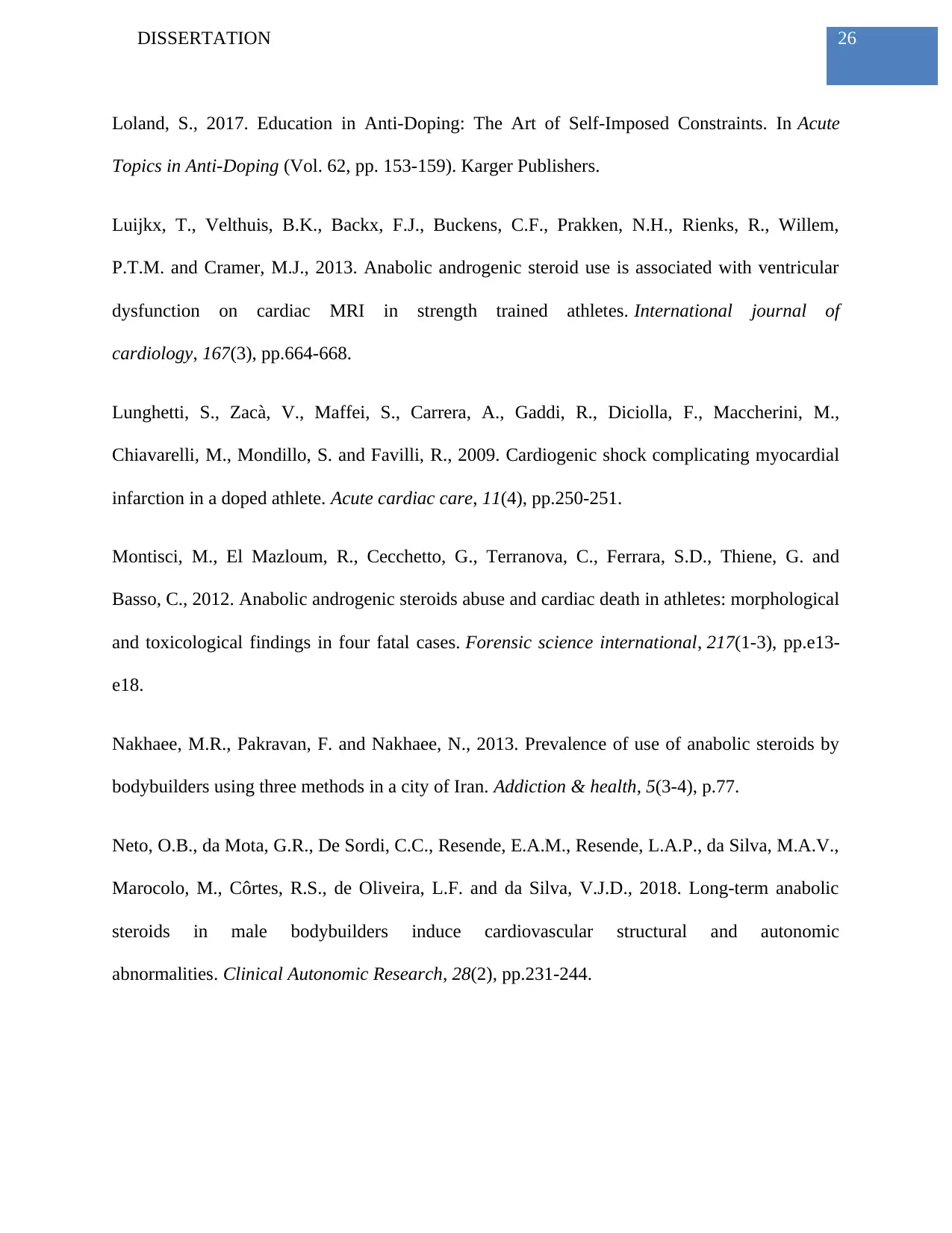
26DISSERTATION
Loland, S., 2017. Education in Anti-Doping: The Art of Self-Imposed Constraints. In Acute
Topics in Anti-Doping (Vol. 62, pp. 153-159). Karger Publishers.
Luijkx, T., Velthuis, B.K., Backx, F.J., Buckens, C.F., Prakken, N.H., Rienks, R., Willem,
P.T.M. and Cramer, M.J., 2013. Anabolic androgenic steroid use is associated with ventricular
dysfunction on cardiac MRI in strength trained athletes. International journal of
cardiology, 167(3), pp.664-668.
Lunghetti, S., Zacà, V., Maffei, S., Carrera, A., Gaddi, R., Diciolla, F., Maccherini, M.,
Chiavarelli, M., Mondillo, S. and Favilli, R., 2009. Cardiogenic shock complicating myocardial
infarction in a doped athlete. Acute cardiac care, 11(4), pp.250-251.
Montisci, M., El Mazloum, R., Cecchetto, G., Terranova, C., Ferrara, S.D., Thiene, G. and
Basso, C., 2012. Anabolic androgenic steroids abuse and cardiac death in athletes: morphological
and toxicological findings in four fatal cases. Forensic science international, 217(1-3), pp.e13-
e18.
Nakhaee, M.R., Pakravan, F. and Nakhaee, N., 2013. Prevalence of use of anabolic steroids by
bodybuilders using three methods in a city of Iran. Addiction & health, 5(3-4), p.77.
Neto, O.B., da Mota, G.R., De Sordi, C.C., Resende, E.A.M., Resende, L.A.P., da Silva, M.A.V.,
Marocolo, M., Côrtes, R.S., de Oliveira, L.F. and da Silva, V.J.D., 2018. Long-term anabolic
steroids in male bodybuilders induce cardiovascular structural and autonomic
abnormalities. Clinical Autonomic Research, 28(2), pp.231-244.
Loland, S., 2017. Education in Anti-Doping: The Art of Self-Imposed Constraints. In Acute
Topics in Anti-Doping (Vol. 62, pp. 153-159). Karger Publishers.
Luijkx, T., Velthuis, B.K., Backx, F.J., Buckens, C.F., Prakken, N.H., Rienks, R., Willem,
P.T.M. and Cramer, M.J., 2013. Anabolic androgenic steroid use is associated with ventricular
dysfunction on cardiac MRI in strength trained athletes. International journal of
cardiology, 167(3), pp.664-668.
Lunghetti, S., Zacà, V., Maffei, S., Carrera, A., Gaddi, R., Diciolla, F., Maccherini, M.,
Chiavarelli, M., Mondillo, S. and Favilli, R., 2009. Cardiogenic shock complicating myocardial
infarction in a doped athlete. Acute cardiac care, 11(4), pp.250-251.
Montisci, M., El Mazloum, R., Cecchetto, G., Terranova, C., Ferrara, S.D., Thiene, G. and
Basso, C., 2012. Anabolic androgenic steroids abuse and cardiac death in athletes: morphological
and toxicological findings in four fatal cases. Forensic science international, 217(1-3), pp.e13-
e18.
Nakhaee, M.R., Pakravan, F. and Nakhaee, N., 2013. Prevalence of use of anabolic steroids by
bodybuilders using three methods in a city of Iran. Addiction & health, 5(3-4), p.77.
Neto, O.B., da Mota, G.R., De Sordi, C.C., Resende, E.A.M., Resende, L.A.P., da Silva, M.A.V.,
Marocolo, M., Côrtes, R.S., de Oliveira, L.F. and da Silva, V.J.D., 2018. Long-term anabolic
steroids in male bodybuilders induce cardiovascular structural and autonomic
abnormalities. Clinical Autonomic Research, 28(2), pp.231-244.
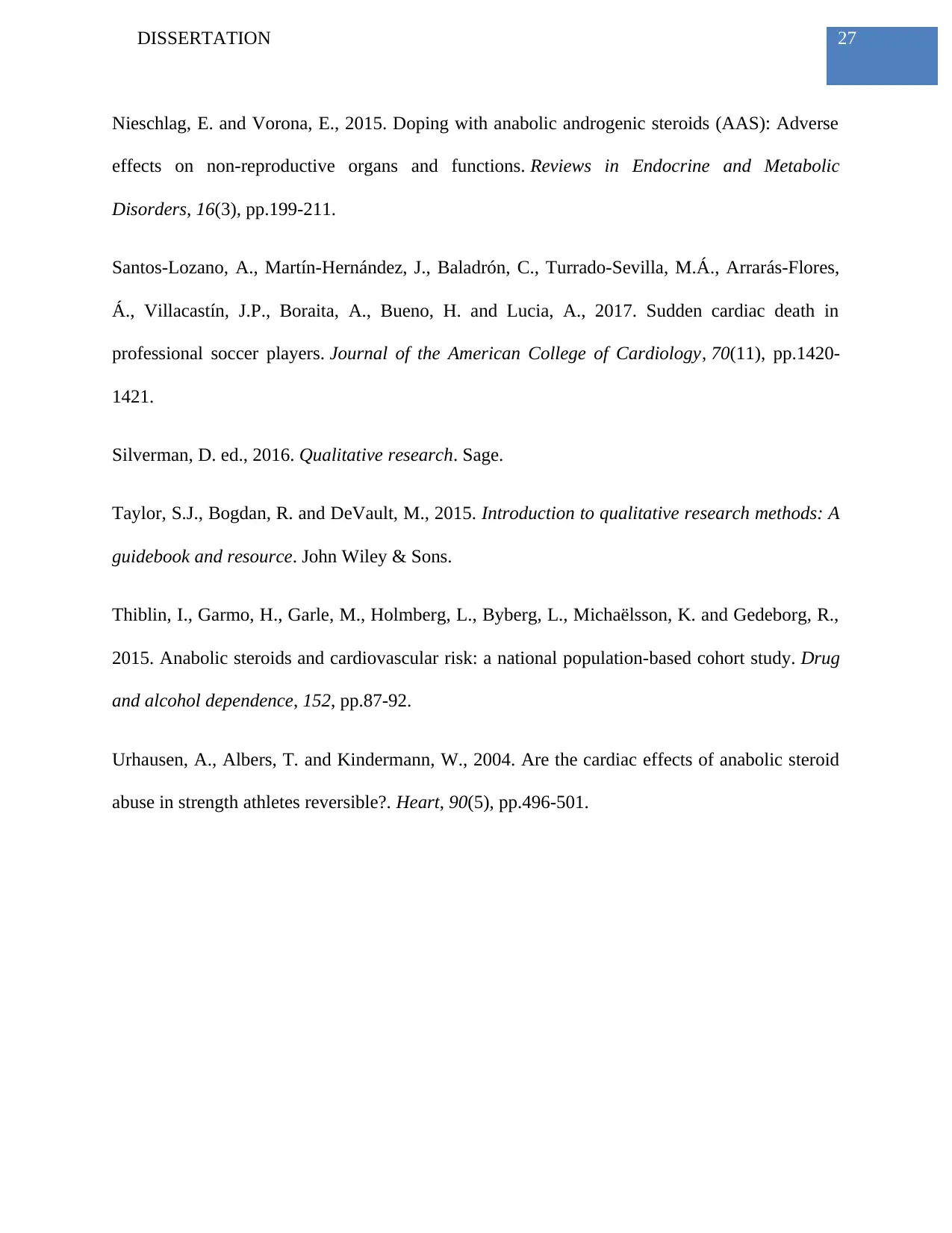
27DISSERTATION
Nieschlag, E. and Vorona, E., 2015. Doping with anabolic androgenic steroids (AAS): Adverse
effects on non-reproductive organs and functions. Reviews in Endocrine and Metabolic
Disorders, 16(3), pp.199-211.
Santos-Lozano, A., Martín-Hernández, J., Baladrón, C., Turrado-Sevilla, M.Á., Arrarás-Flores,
Á., Villacastín, J.P., Boraita, A., Bueno, H. and Lucia, A., 2017. Sudden cardiac death in
professional soccer players. Journal of the American College of Cardiology, 70(11), pp.1420-
1421.
Silverman, D. ed., 2016. Qualitative research. Sage.
Taylor, S.J., Bogdan, R. and DeVault, M., 2015. Introduction to qualitative research methods: A
guidebook and resource. John Wiley & Sons.
Thiblin, I., Garmo, H., Garle, M., Holmberg, L., Byberg, L., Michaëlsson, K. and Gedeborg, R.,
2015. Anabolic steroids and cardiovascular risk: a national population-based cohort study. Drug
and alcohol dependence, 152, pp.87-92.
Urhausen, A., Albers, T. and Kindermann, W., 2004. Are the cardiac effects of anabolic steroid
abuse in strength athletes reversible?. Heart, 90(5), pp.496-501.
Nieschlag, E. and Vorona, E., 2015. Doping with anabolic androgenic steroids (AAS): Adverse
effects on non-reproductive organs and functions. Reviews in Endocrine and Metabolic
Disorders, 16(3), pp.199-211.
Santos-Lozano, A., Martín-Hernández, J., Baladrón, C., Turrado-Sevilla, M.Á., Arrarás-Flores,
Á., Villacastín, J.P., Boraita, A., Bueno, H. and Lucia, A., 2017. Sudden cardiac death in
professional soccer players. Journal of the American College of Cardiology, 70(11), pp.1420-
1421.
Silverman, D. ed., 2016. Qualitative research. Sage.
Taylor, S.J., Bogdan, R. and DeVault, M., 2015. Introduction to qualitative research methods: A
guidebook and resource. John Wiley & Sons.
Thiblin, I., Garmo, H., Garle, M., Holmberg, L., Byberg, L., Michaëlsson, K. and Gedeborg, R.,
2015. Anabolic steroids and cardiovascular risk: a national population-based cohort study. Drug
and alcohol dependence, 152, pp.87-92.
Urhausen, A., Albers, T. and Kindermann, W., 2004. Are the cardiac effects of anabolic steroid
abuse in strength athletes reversible?. Heart, 90(5), pp.496-501.
1 out of 28
Related Documents
Your All-in-One AI-Powered Toolkit for Academic Success.
+13062052269
info@desklib.com
Available 24*7 on WhatsApp / Email
![[object Object]](/_next/static/media/star-bottom.7253800d.svg)
Unlock your academic potential
© 2024 | Zucol Services PVT LTD | All rights reserved.





